During a brief business stay in Uganda, our dear hosts, led by the fantastic, intelligent, beautiful and exceptionally charming Susan, organised a trip for us to the Murchison Falls National Park.
Generally speaking, the town of Masindi, where I stayed, is considered the main urban station before visiting this important national park in the northwest of Uganda. Some say it’s in the western part of the country, but to me, it looks more like the northwest. In any case, here’s a map of Uganda with marked locations where I stayed during this journey.
So, from Masindi to the main entrance of the national park near the location of Paraa, which is practically in the centre of the park, there is a good, paved road approximately 87 km long. However, you enter the territory of the park after about 20 kilometres.
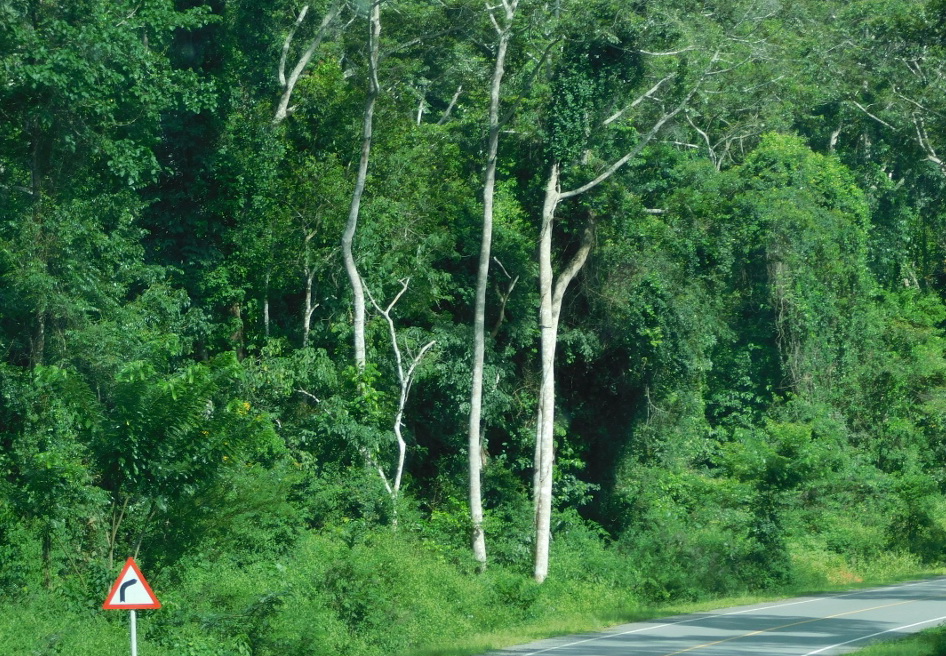 On the way to the Murchison Falls NP
On the way to the Murchison Falls NP
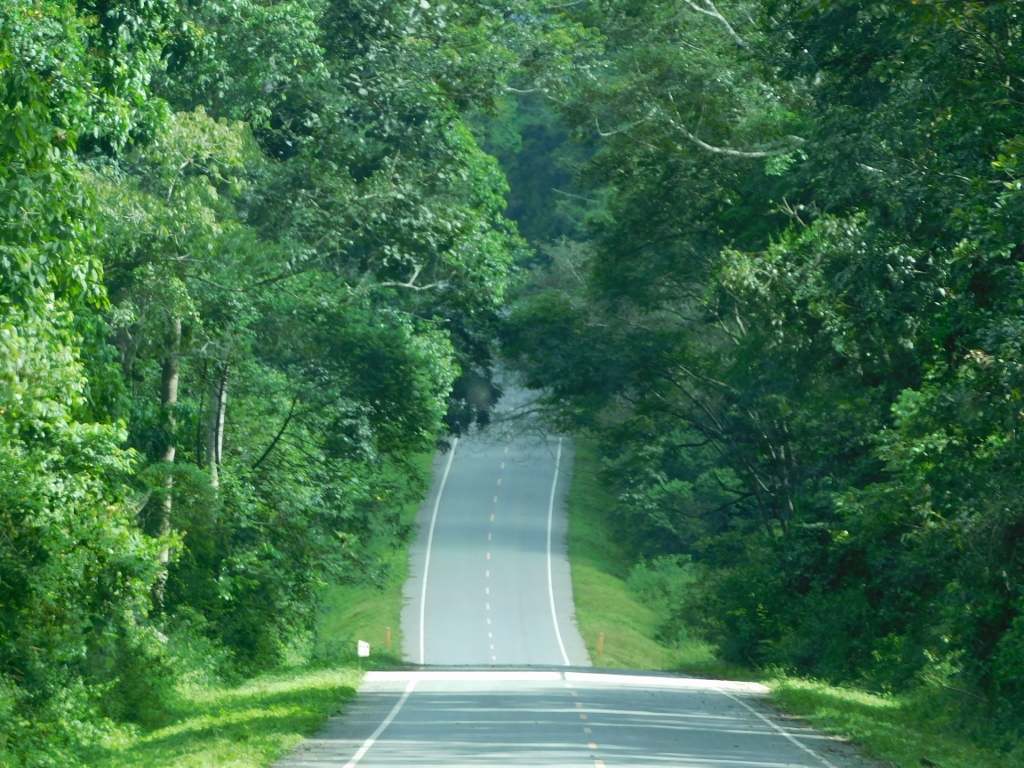 On the way to the Murchison Falls NP
On the way to the Murchison Falls NP
I have mentioned earlier that Masindi is situated at an altitude of over 1200 meters, while the central parts of the national park are at a lower elevation. Therefore, in one section, the road descends, revealing a sea of forests ahead.
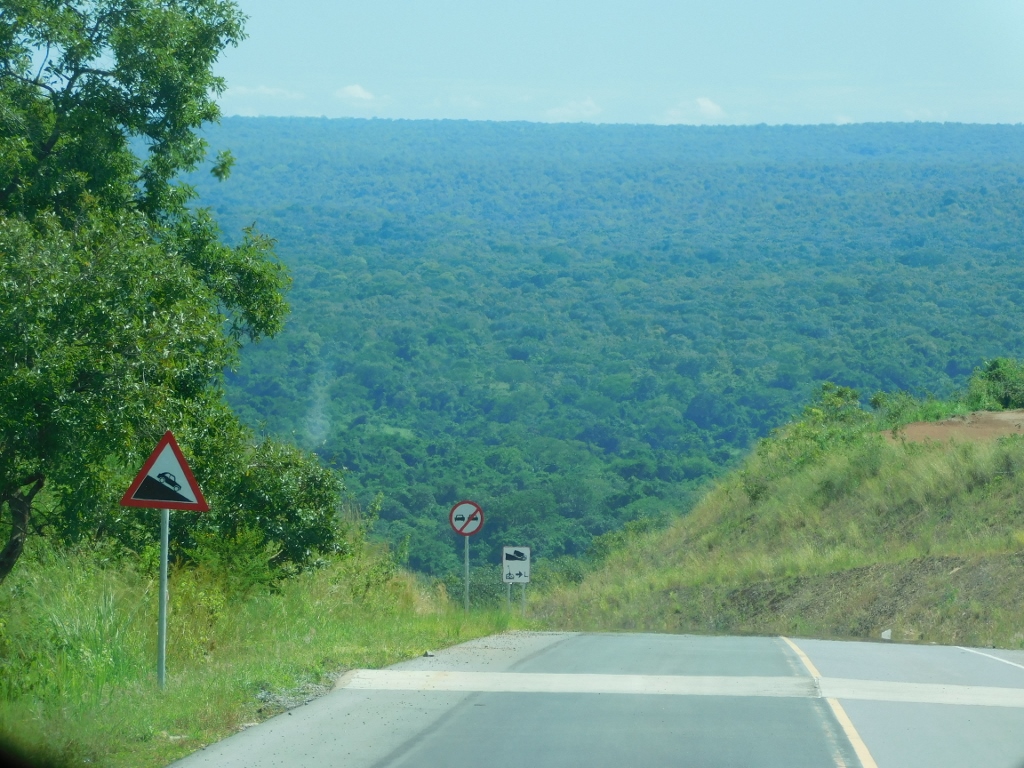 On the way to the Murchison Falls NP
On the way to the Murchison Falls NP
When we entered the forested area, we were greeted by local residents – olive baboons (Papio anubis) that are the most widespread among the six baboon species. They certainly inhabit the forest here, but being opportunistic, they have become accustomed to park visitors tossing them a banana or two. So, they patiently wait for someone to pass by.
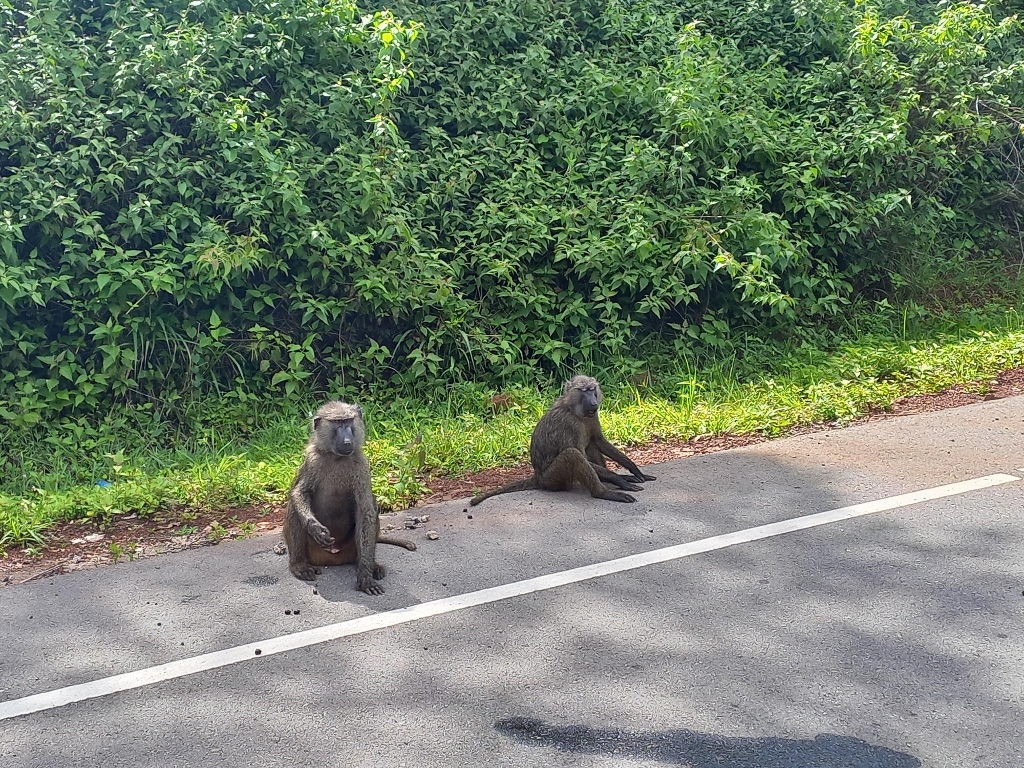 Baboons waiting for “fast food”
Baboons waiting for “fast food”
However, at one point, we noticed another species of monkey in the treetops – the black-and-white colobus. There are several species and subspecies of this monkey, but all belong to the genus Colobus.
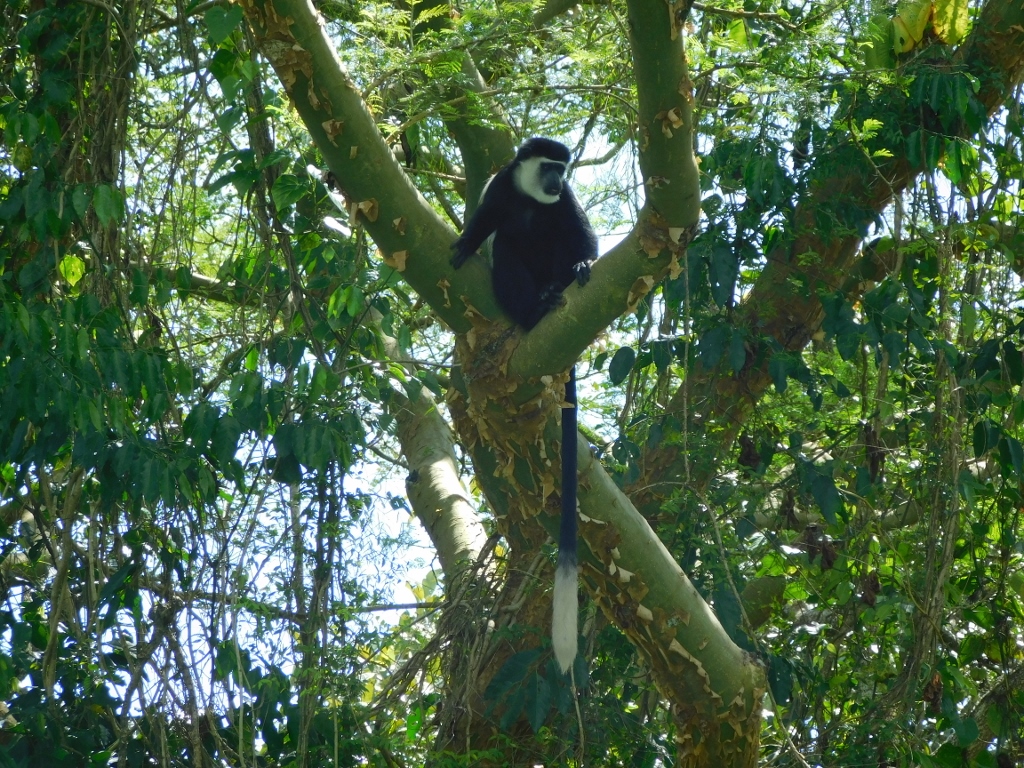 Black-and-white colobus
Black-and-white colobus
Not far from it, in the canopy of another tree, an olive baboon was sitting.
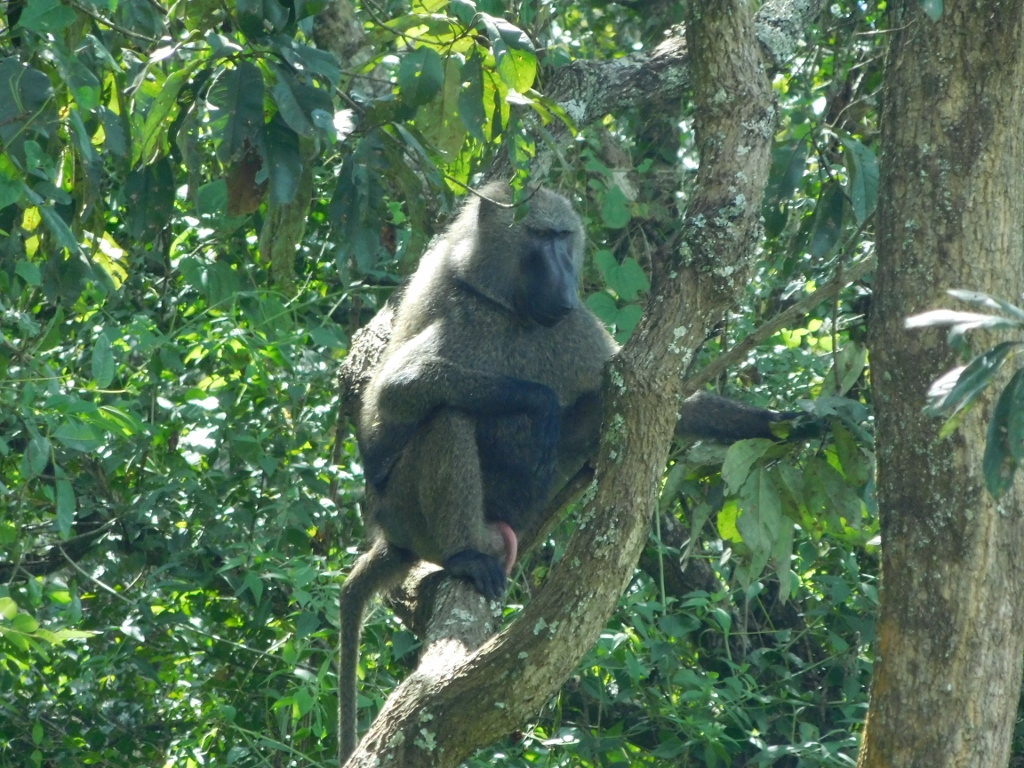 Baboon
Baboon
After a while, the road brought us closer to the lower sections of the park.
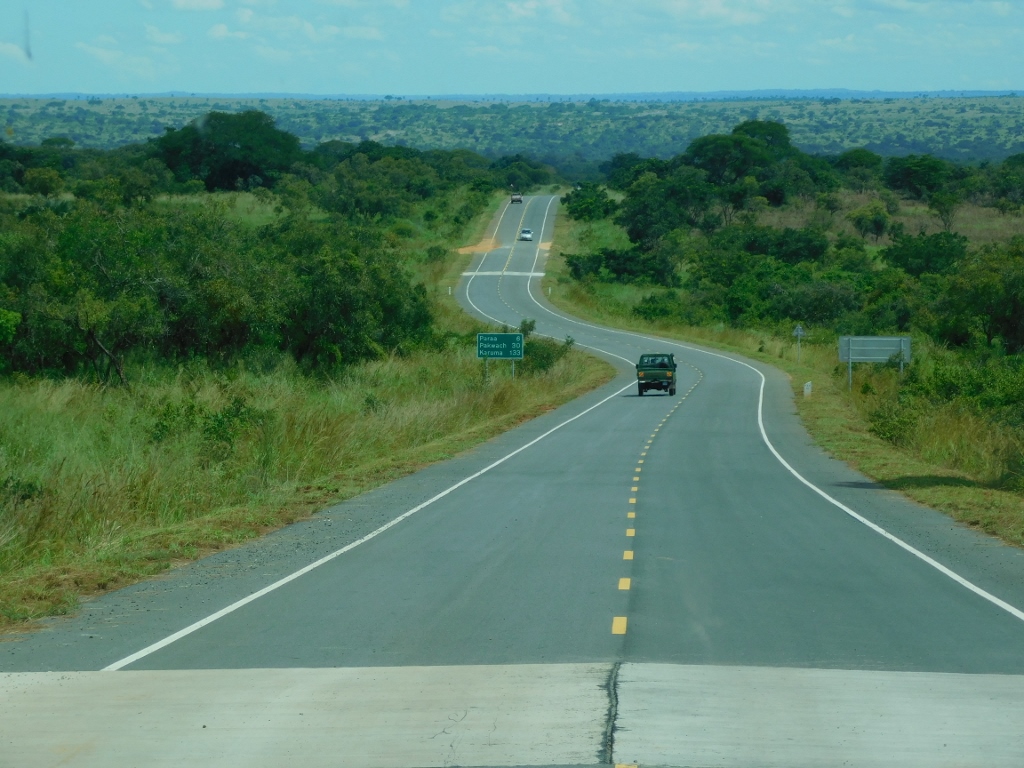 Road through the Murchison Falls NP
Road through the Murchison Falls NP
At one point, we took a short break and so I noticed a remarkably colourful lizard on a small building. It was evident that it had recently lost its tail, while a new one had started to grow, but this did not diminish its beauty in the least. From what I could gather, this was a rainbow agama lizard (Agama agama).
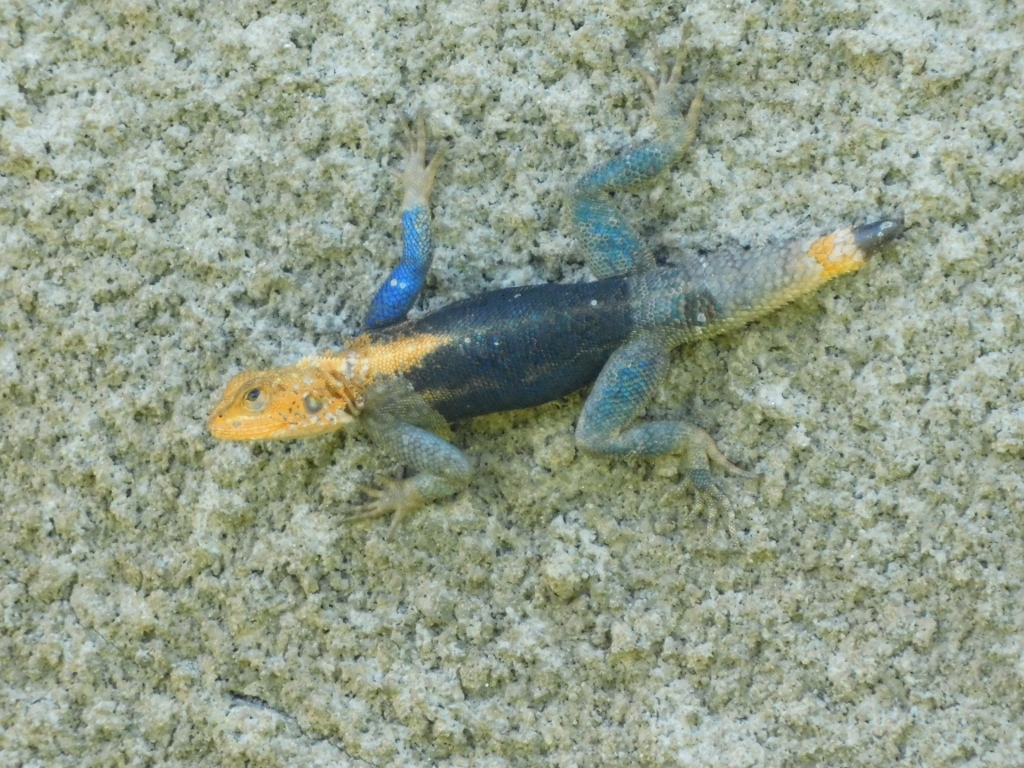 Rainbow agama lizard
Rainbow agama lizard
At the place where we took that short break, there is also a beautiful viewpoint from which you could see the flat part of the national park and the Victoria Nile River. However, I first took a photo of a bird – spotted morning-thrush (Cichladusa guttata).
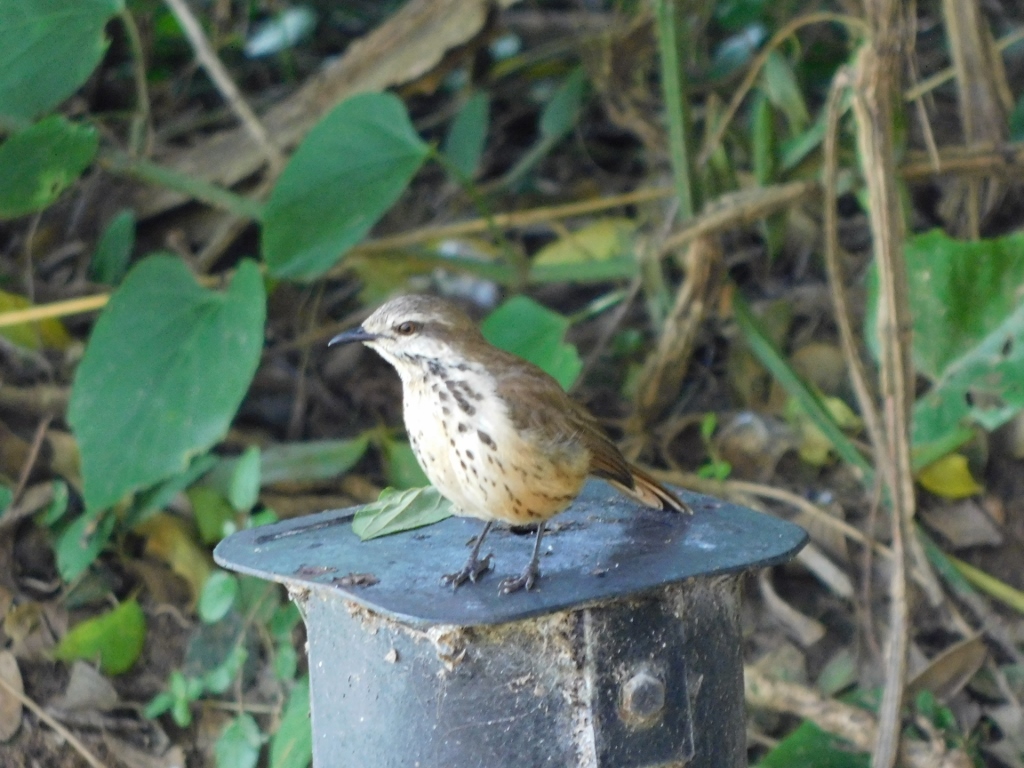 Spotted morning-thrush
Spotted morning-thrush
The Victoria Nile is a part of the White Nile that, together with the Blue Nile, forms the Nile, the longest river in the world, with a total length of 6650 km, including all its tributaries. There are differing opinions regarding the source of the White Nile, with some placing it in Rwanda and others in Burundi. In any case, the waters that later form the White Nile fill Lake Victoria, from which the Victoria Nile flows, extending for 400 km. It then passes through Lake Kyoga and later through the Murchison Falls National Park before flowing into Lake Albert. The river also exits Lake Albert and continues northeast as the Albert Nile. About 210 km downstream, it reaches South Sudan, where its name changes to Bahr-al-Jabal.
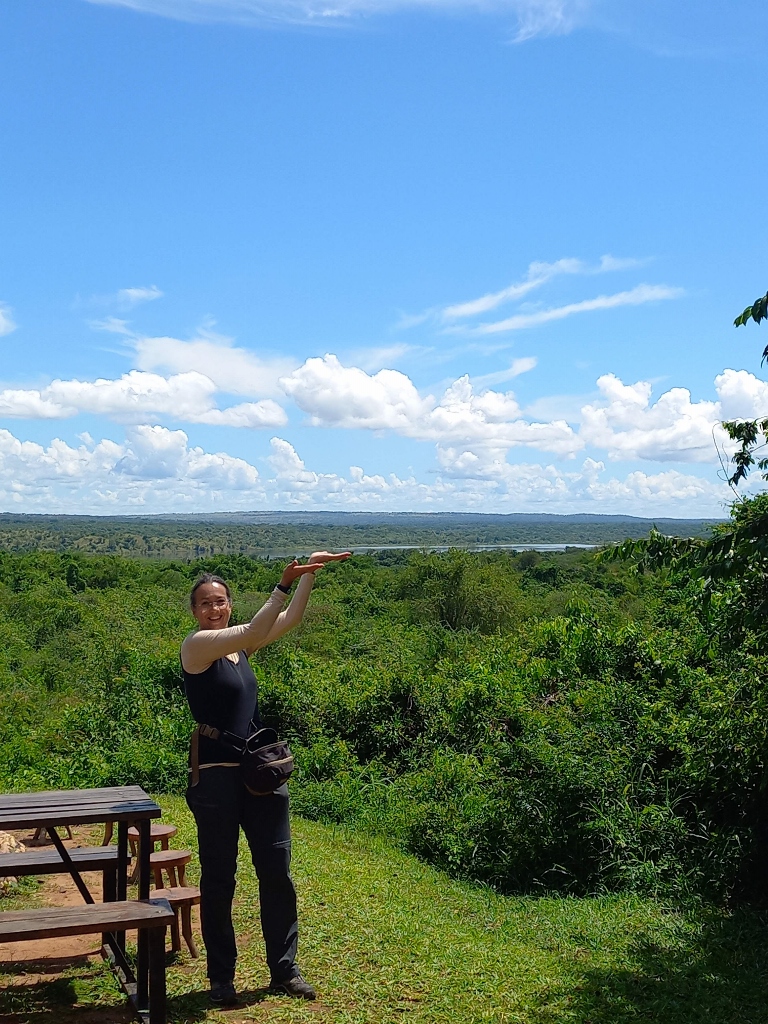 Here is the Victoria Nile
Here is the Victoria Nile
Later on, we continued our journey towards the river.
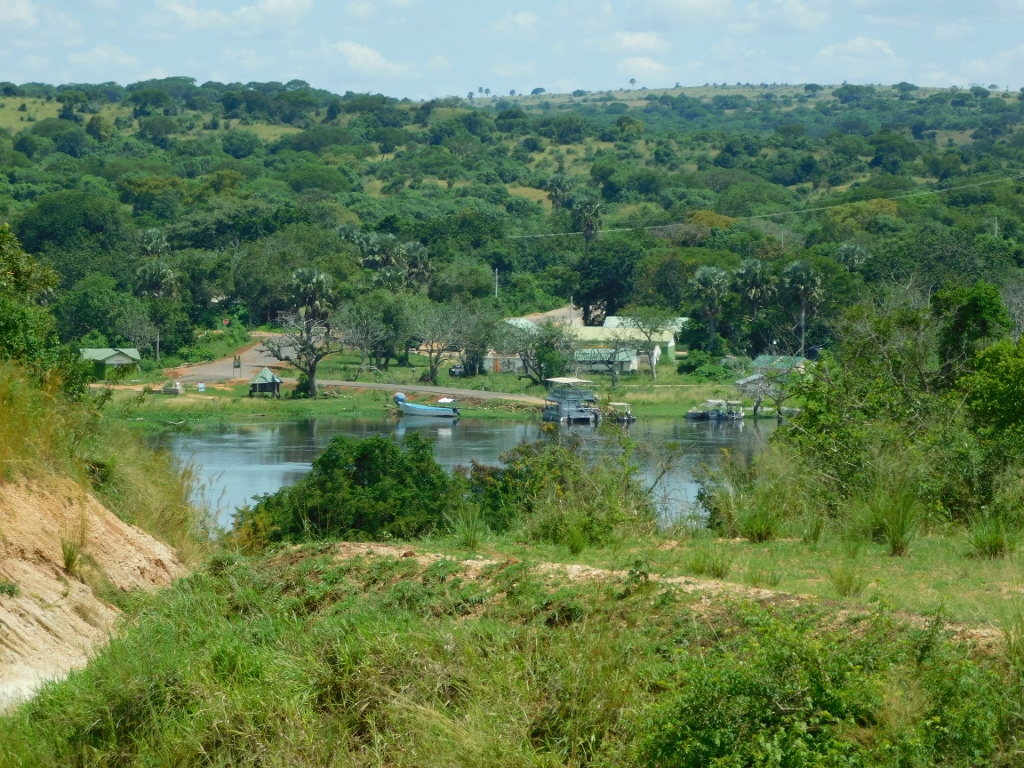 Getting close to the Victoria Nile
Getting close to the Victoria Nile
The Victoria Nile in fact divides the national park into northern and southern parts over a length of 100 km. There is a ferry at one point where you can cross the river, but we chose to cross it using a bridge.
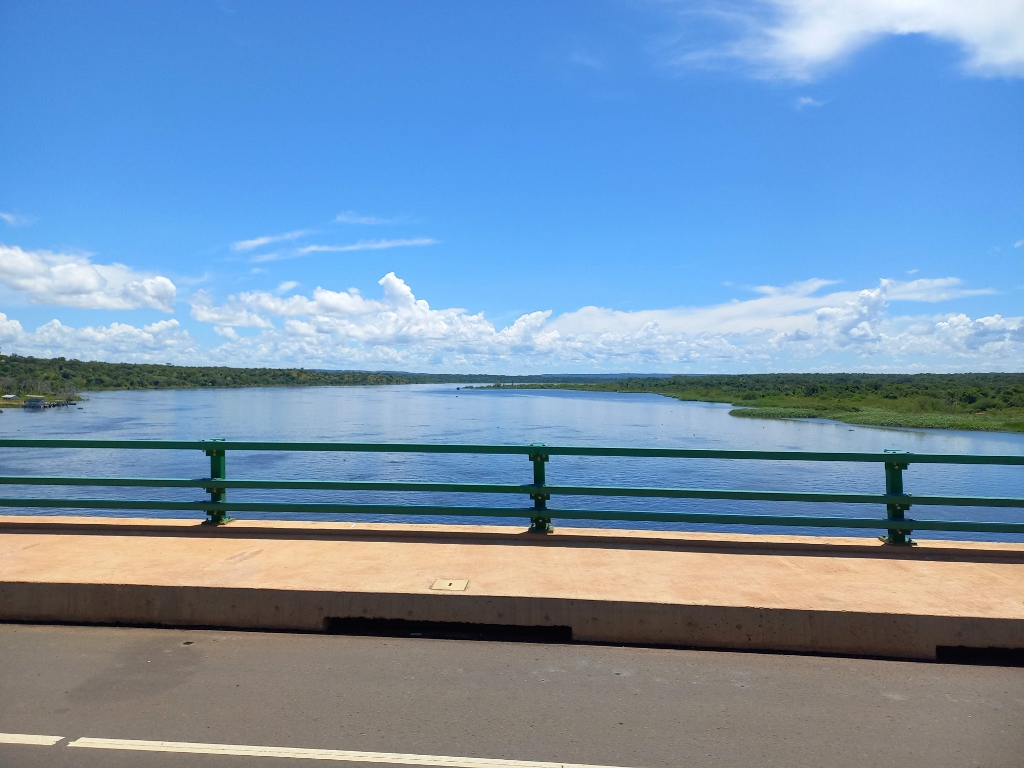 The Victoria Nile
The Victoria Nile
After crossing to the northern bank of the river, we descended to a point where a very charming woman joined us as our guide for exploring the national park. While waiting for everything to be arranged, I took photos of common warthogs (Phacochoerus africanus) enjoying the shade. They were so indifferent to our presence that I thought they were well on their way to turning into domesticated pigs.
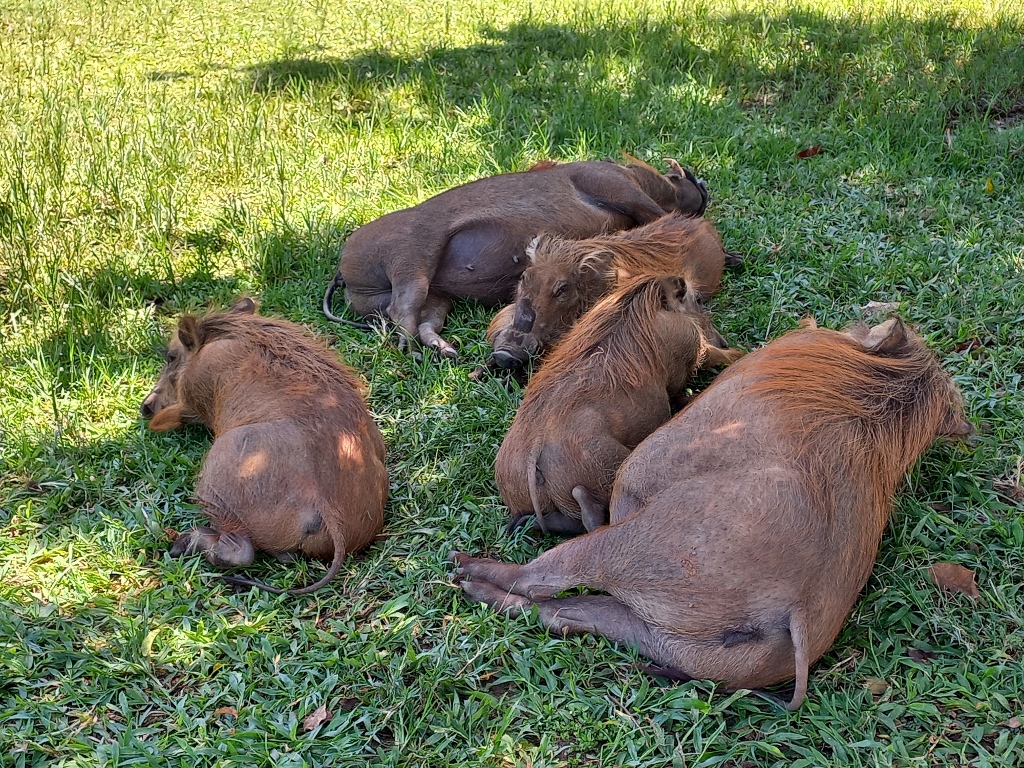 Common warthogs enjoying the shade
Common warthogs enjoying the shade
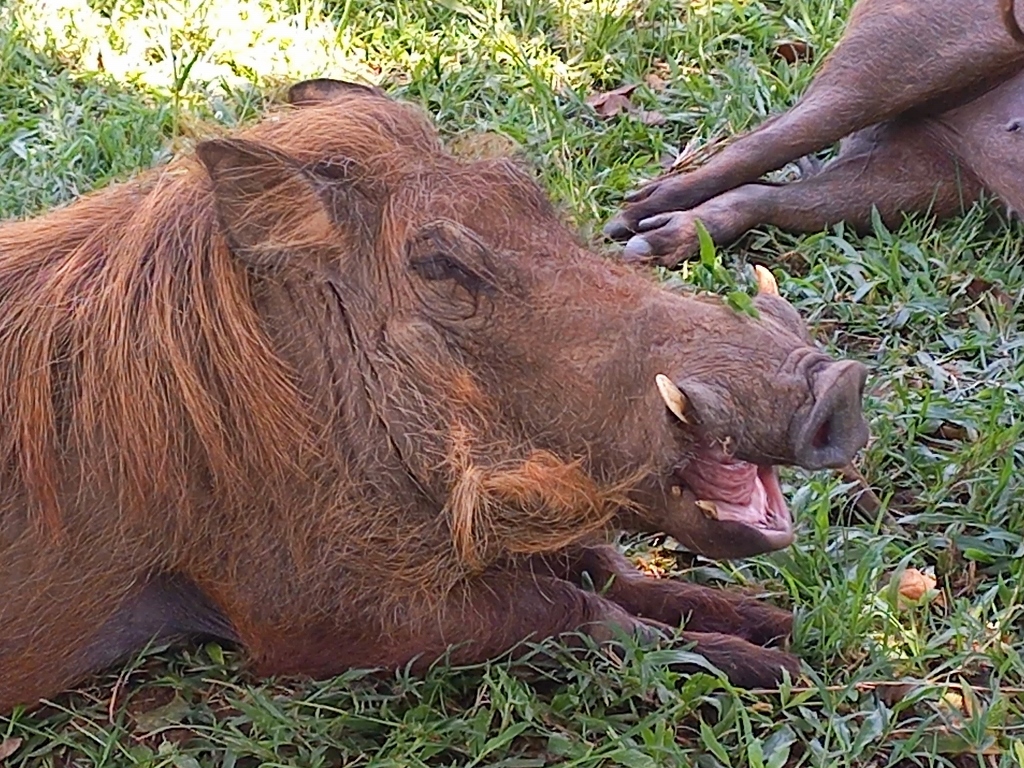 Common warthog
Common warthog
Soon, we embarked on a proper exploration of a part of the national park. Shortly after leaving the asphalt road, we encountered a splendid specimen of a male defassa waterbuck (Kobus ellipsiprymnus) that was standing here and posing for us calmly and patiently.
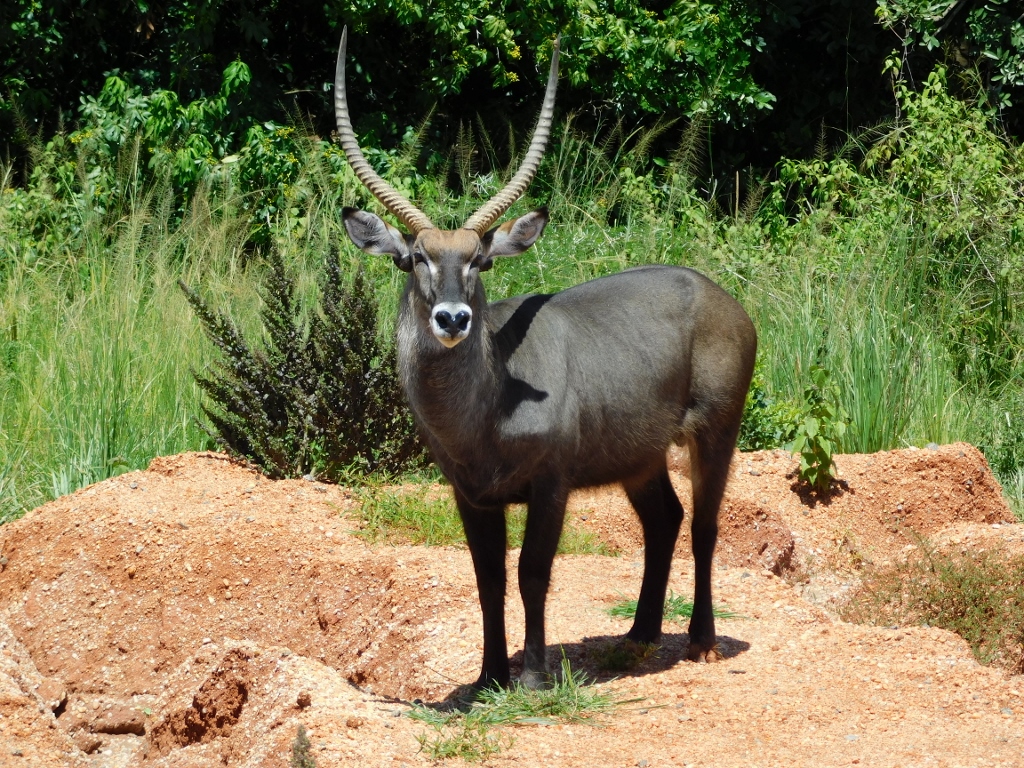 Defassa waterbuck
Defassa waterbuck
We didn’t have to wait long before encountering another fascinating animal, a whole small herd of it, though a bit further from the road. They were African buffaloes (Syncerus caffer) enjoying a good roll in the mud.
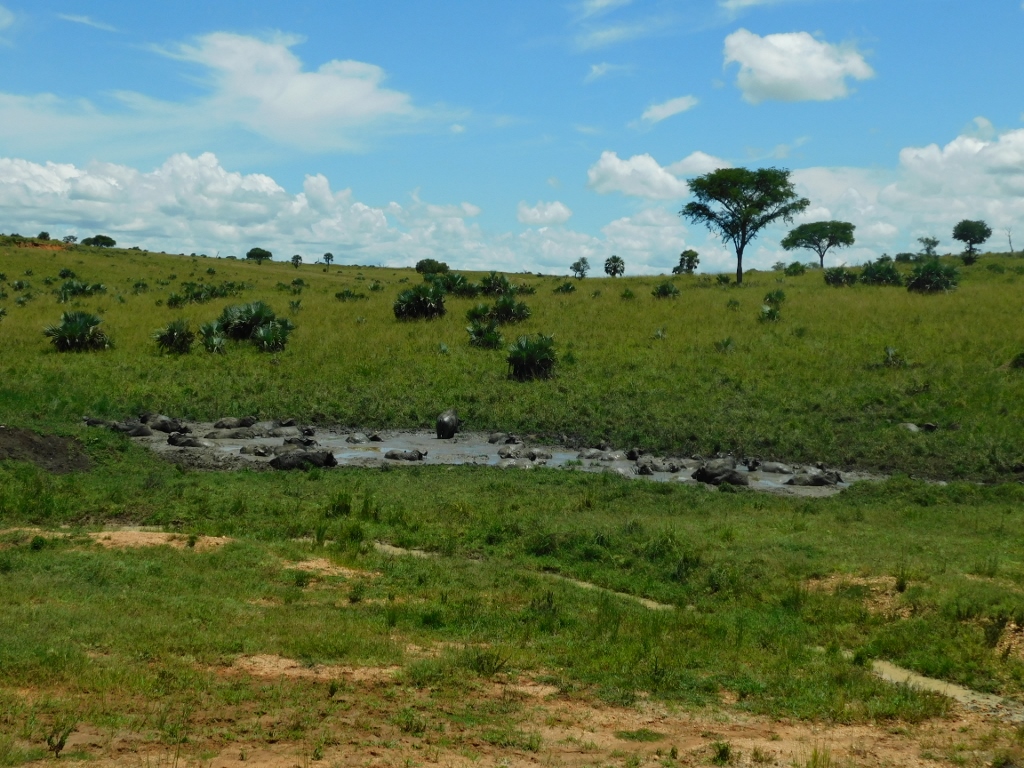 African buffalos
African buffalos
This rolling in the mud isn’t just a matter of enjoyment; it’s also essential. On the one hand, it acts as a sunscreen for them and, on the other hand, it helps protect them from insects and parasites in general. And if that doesn’t do the trick, there are always cattle egrets (Bubulcus ibis) ready to assist.
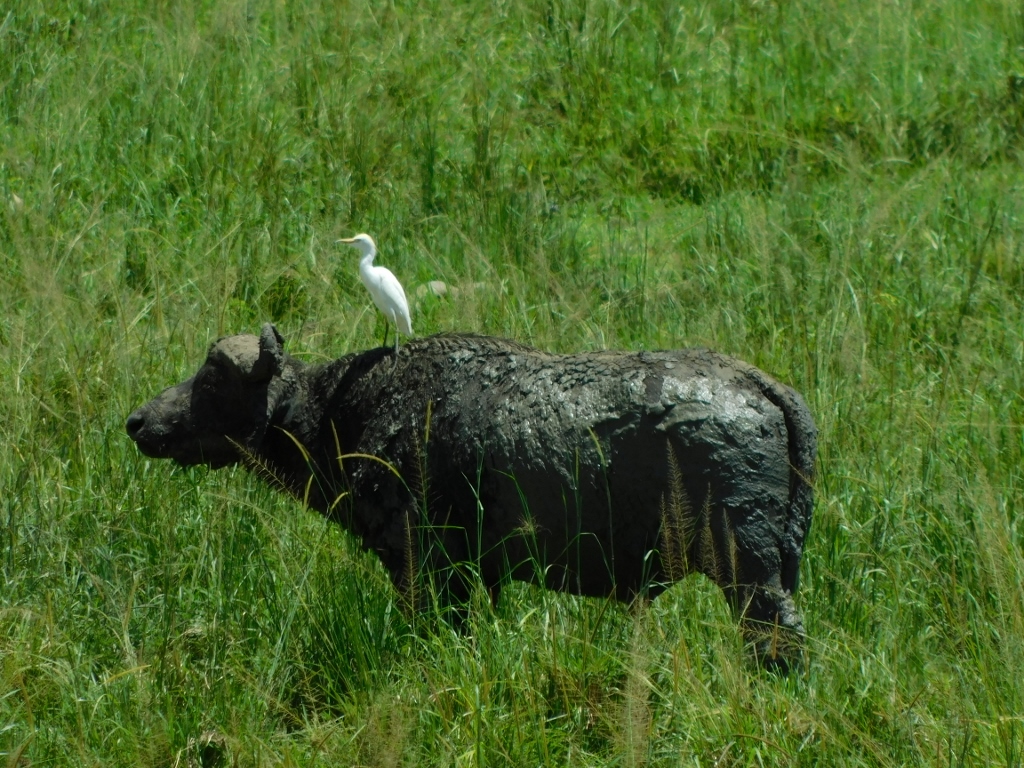 Freshly mudded African buffalo and a cattle egret
Freshly mudded African buffalo and a cattle egret
A bit further, behind the tall grass, we spotted a couple of African buffaloes that had found a small pool to wallow in and cool off, given the absence of trees and shade. Although we didn’t disturb them, keeping a sufficient distance, one of them decided to move away a bit.
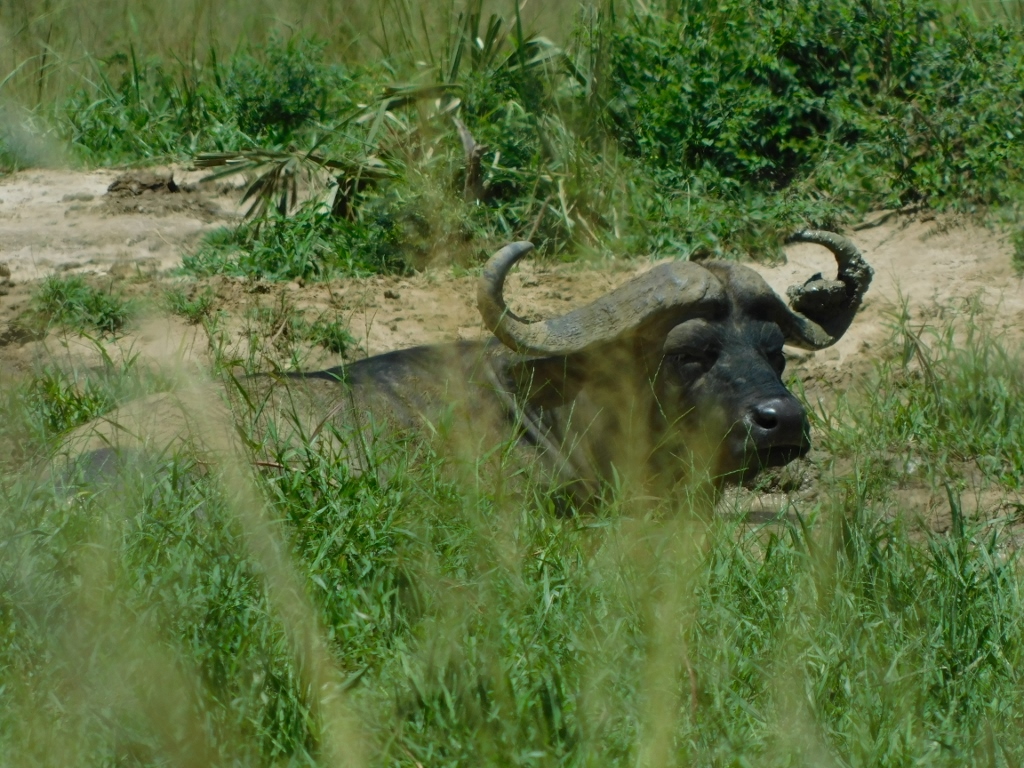 African buffalo
African buffalo
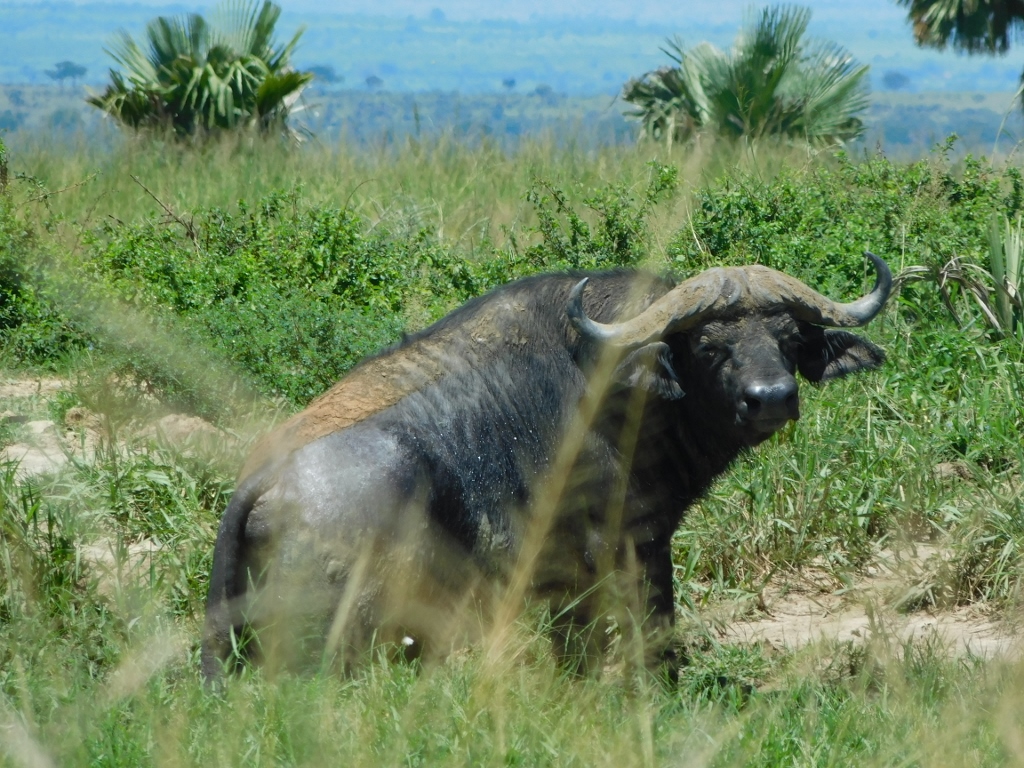 African buffalo
African buffalo
On the way, we also saw a species of small antelope called oribi (Ourebia ourebi).
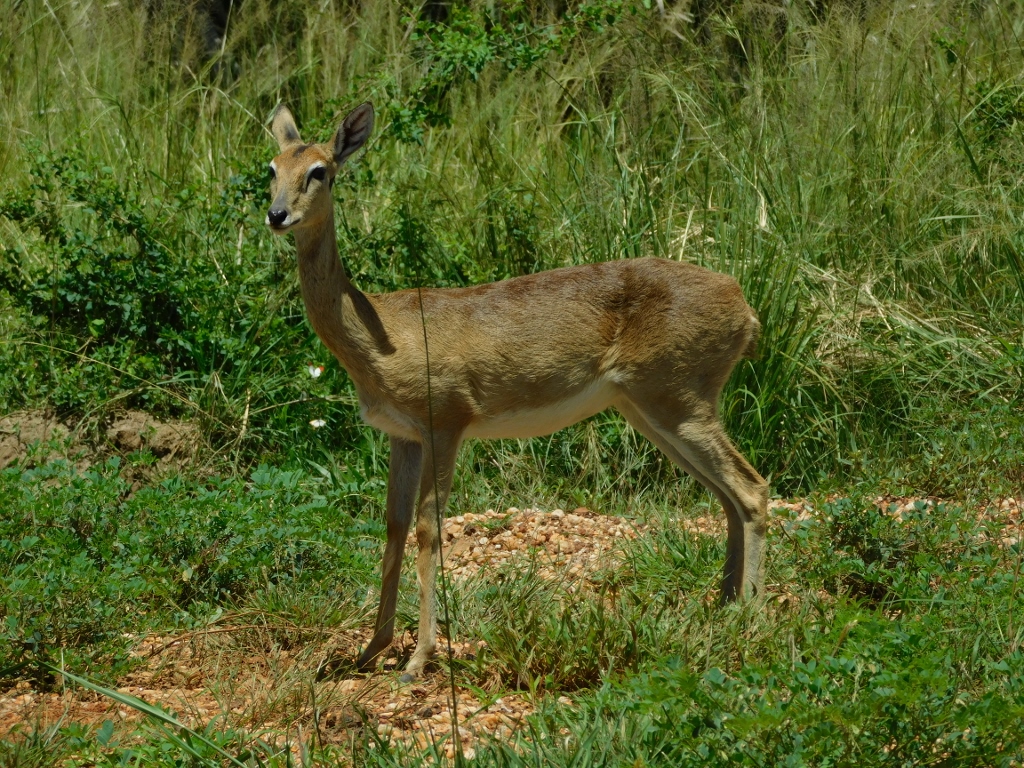 Oribi
Oribi
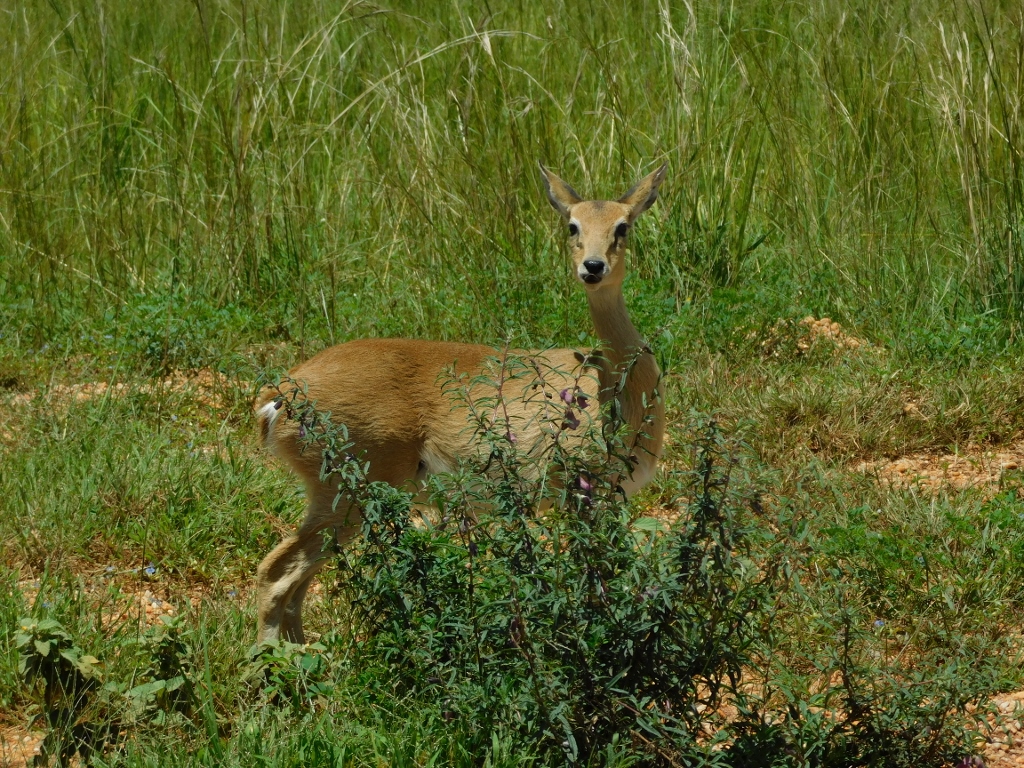 Oribi
Oribi
The Murchison Falls National Park covers an area of 3,840 square kilometres, making it the largest protected area in Uganda. Officially declared a national park in 1952, at the time it was one of the most renowned and considered one of the most beautiful national parks in the entire East Africa. It was famous for its vast number of animals; at one point, due to an “overpopulation” issue, over 3,000 elephants and around 4,000 hippos had to be culled. However, Uganda experienced various political upheavals afterwards, leading to a reduction in animal protection activities and resulting in widespread killing and trafficking of animals. During that period, rhinos were completely exterminated and the number of elephants plummeted from 15,000 to about 250!!! Fortunately, in the early 1990s, the trend changed and over time the surviving animals began to recover.
By the way, the Murchison Falls National Park is part of the Murchison Falls Conservation Area, which, in addition to the Murchison Falls NP, also includes the Bugungu Wildlife Reserve to the west and the Karuma Wildlife Reserve to the east from the national park.
Moreover, in the southern part of the national park, between these two reserves and north of Masindi, lies Kaniyo Pabidi Forest that, together with the Budongo Forest Reserve to the west of Masindi, is home to the largest concentration of chimpanzees in Uganda. Of course, when it comes to birds in these areas, there’s a wealth of diversity – these parts of Uganda are known for a large variety of bird species and bird watching is often offered as a special excursion for interested visitors.
But, let me go back to the story about visit to the Murchison Falls National Park. There are four types of habitats in the park – grass savanna, forest savanna, river habitat and palm habitat – as explained by the woman who was our guide. The most interesting part of this is related to the palms. Namely, palms didn’t naturally grow here, but were spread in the park by elephants that consumed their fruits in the areas north of the national park, later depositing the seeds through their digestive system.
Today, the area where palms grow in higher concentration represents a distinct zone within the park. I found these landscapes very beautiful, so I often took photos as we passed through.
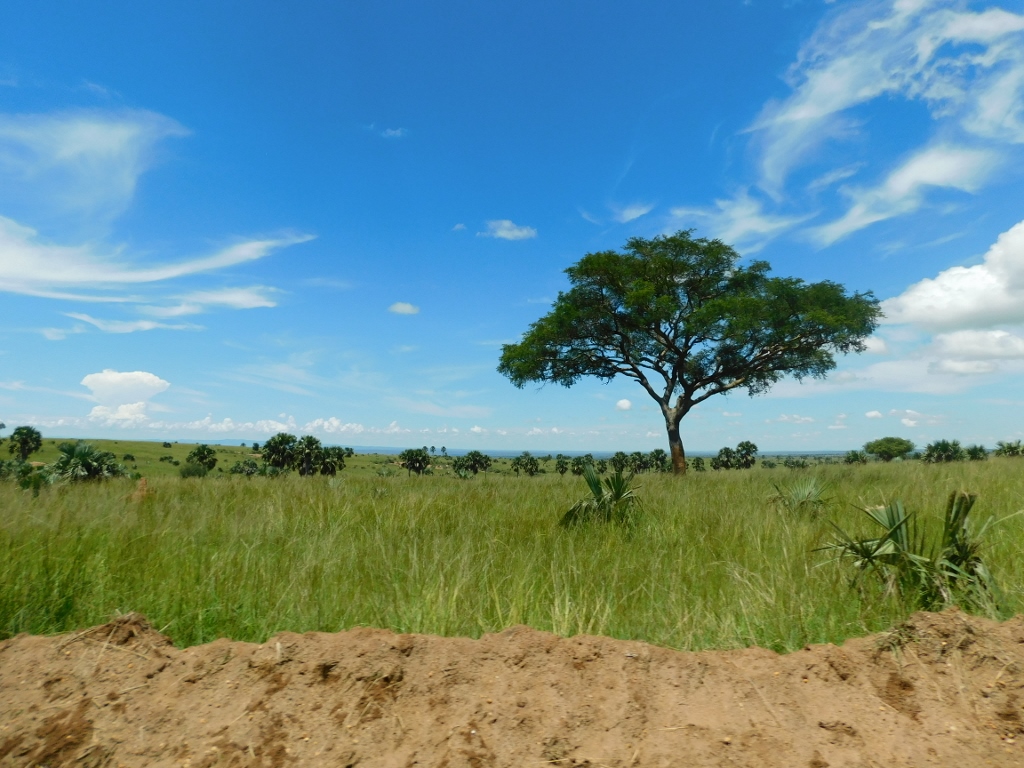 Murchison Falls NP: a little grass, a little palms and an odd tree
Murchison Falls NP: a little grass, a little palms and an odd tree
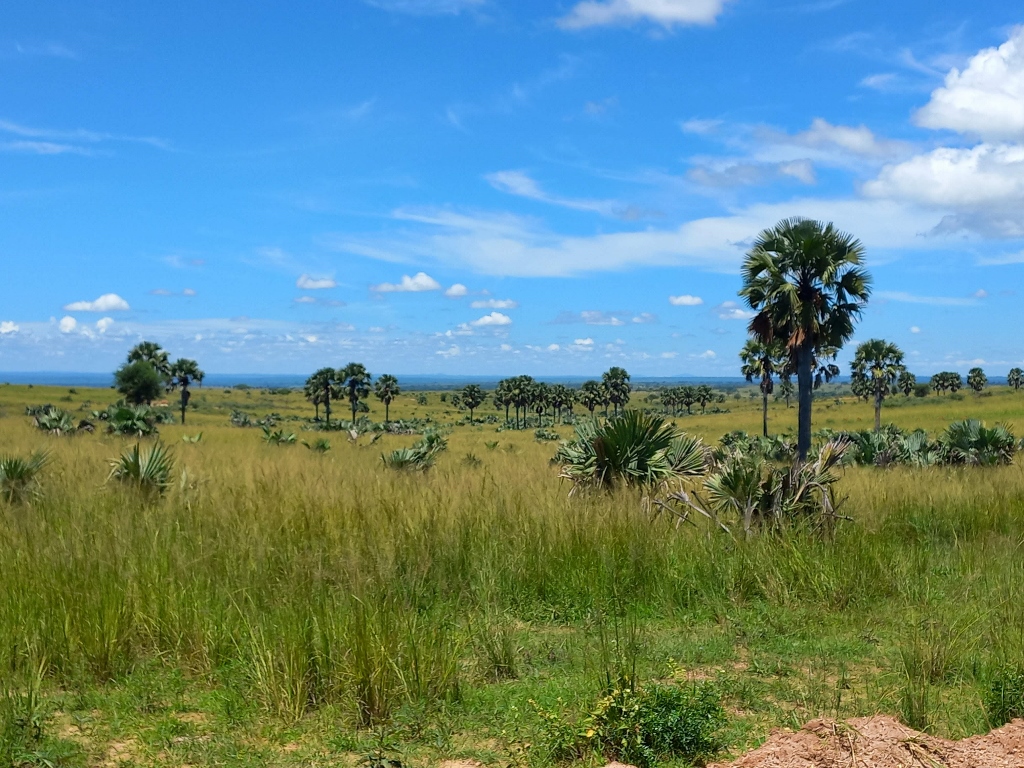 Murchison Falls NP: grass and palms
Murchison Falls NP: grass and palms
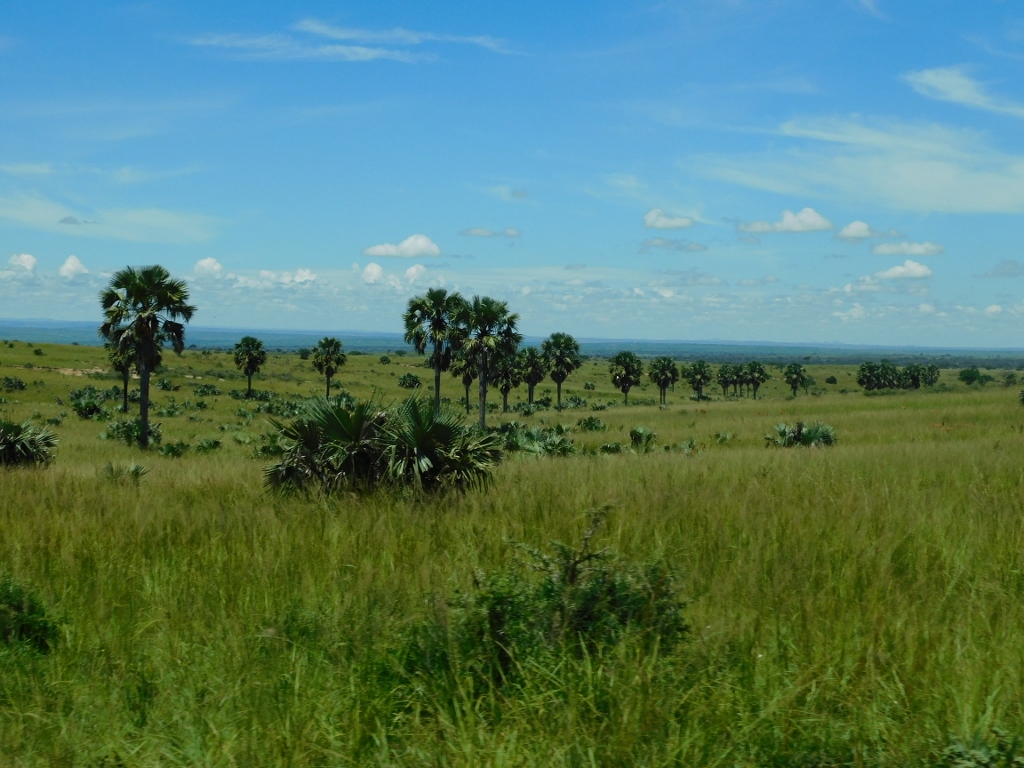 Murchison Falls NP: grass and palms
Murchison Falls NP: grass and palms
 Murchison Falls NP: grass and palms
Murchison Falls NP: grass and palms
And then we gradually moved into the grass savanna, with only an occasional tree or a palm.
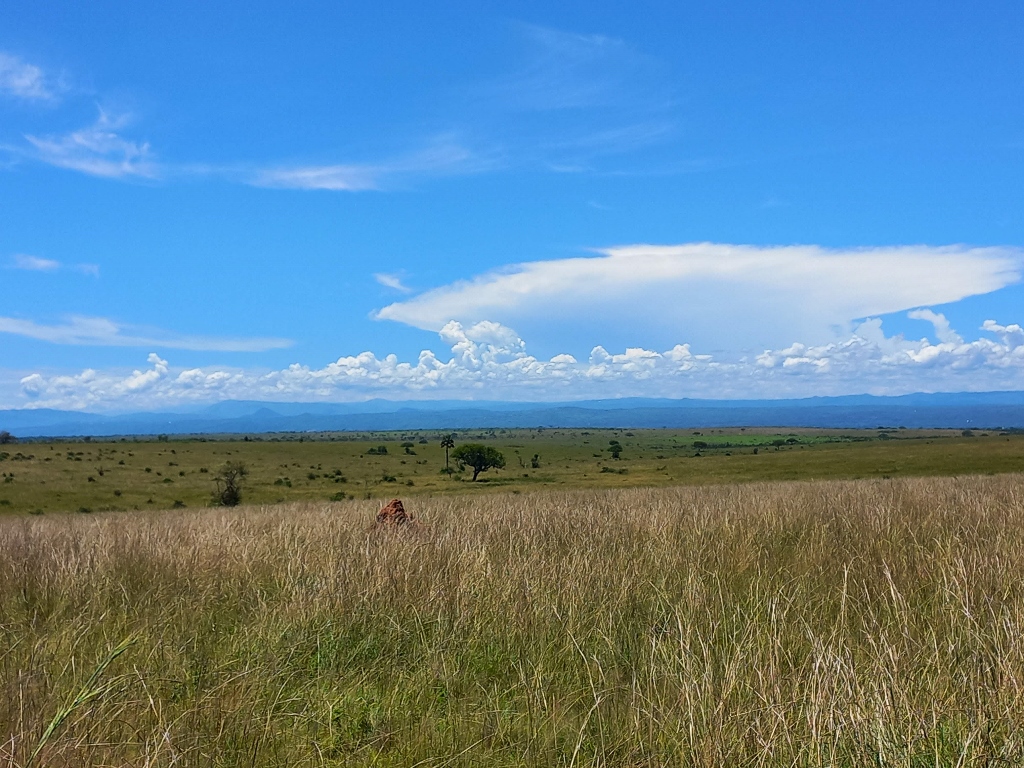 Murchison Falls NP: grass savanna
Murchison Falls NP: grass savanna
There, in the tall grass, I spotted a male of a type of antelope, the bohor reedbuck (Redunca redunca), but the high grass made it a bit challenging to focus the camera.
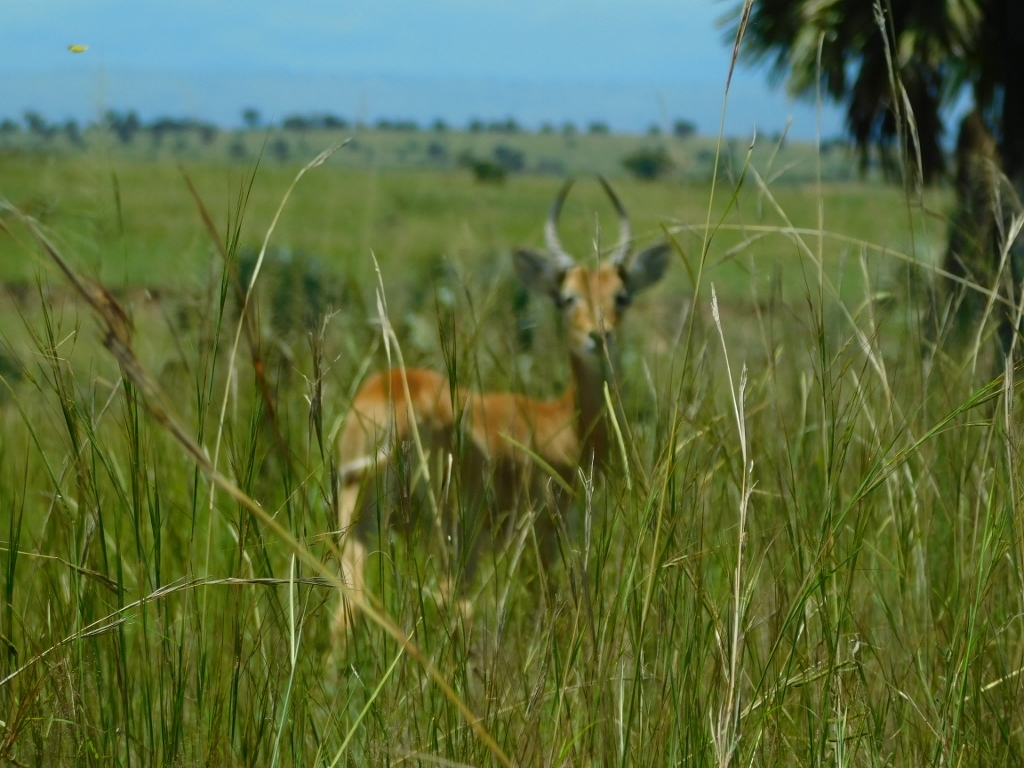 Bohor reedbuck
Bohor reedbuck
Later on, the situation improved and I also had a good view of another interesting animal. Again, it was a type of antelope – the Lelwel hartebeest or Jackson’s hartebeest (Alcelaphus buselaphus lelwel).
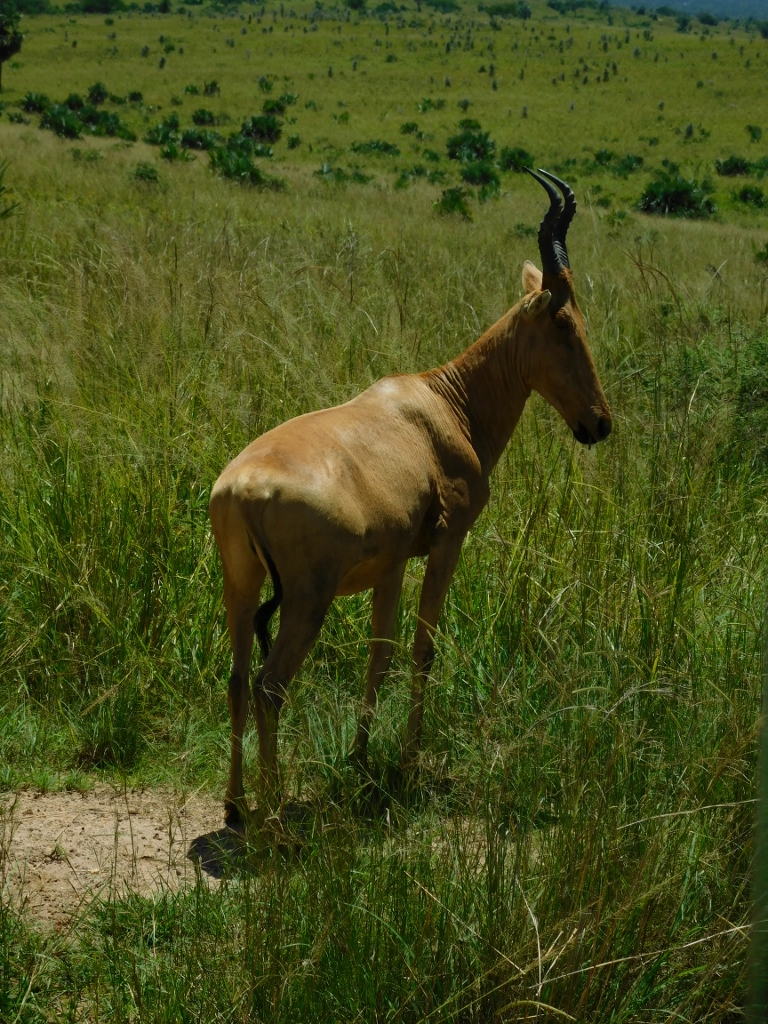 Lelwel hartebeest
Lelwel hartebeest
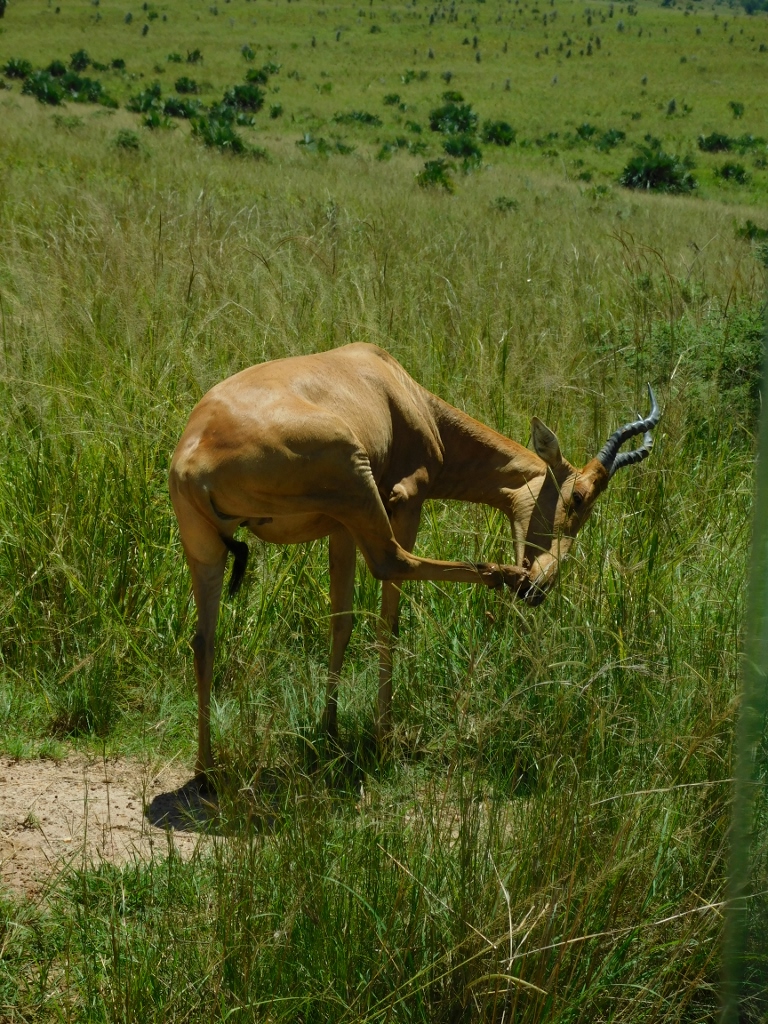 Lelwel hartebeest
Lelwel hartebeest
There was also a type of bird that was hard to miss – not only was it quite large, but also some specimens were casually strolling in several places alongside the dirt road we were on. It’s the Abyssinian ground-hornbill (Bucorvus abyssinicus).
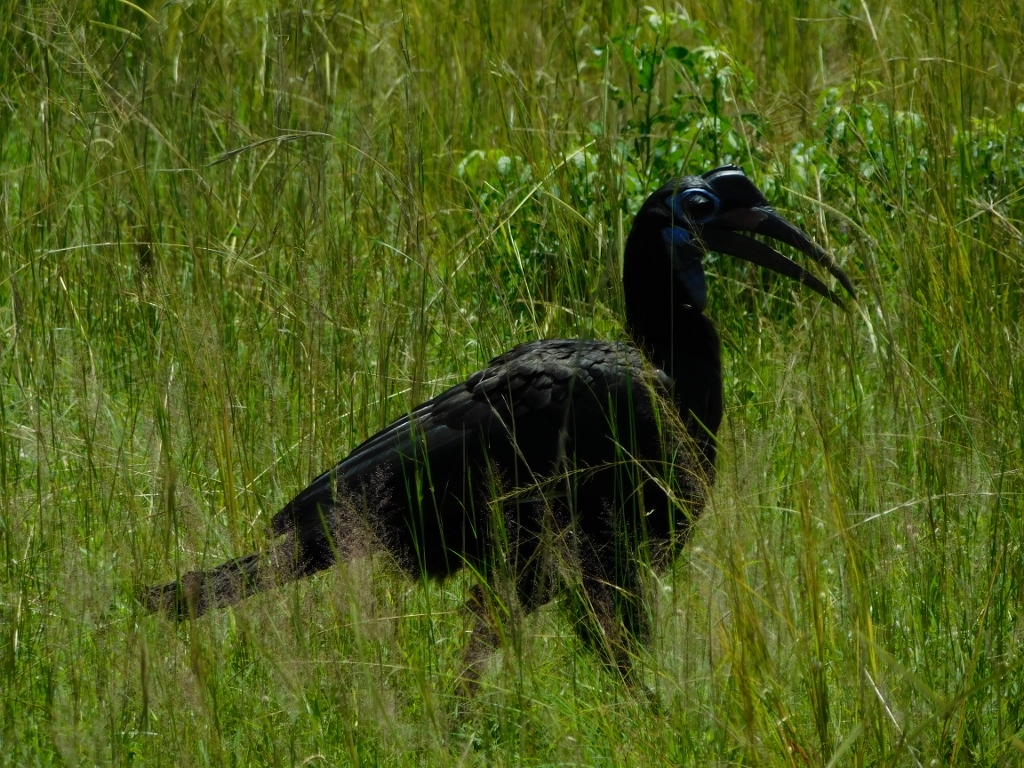 Abyssinian ground-hornbill
Abyssinian ground-hornbill
The Murchison Falls NP is also known as the home to the largest population of the endangered Rothschild’s giraffe (Giraffa camelopardalis rothschildi) in the world. Indeed, a Rothschild’s giraffe was among the first of many giraffes we saw that day.
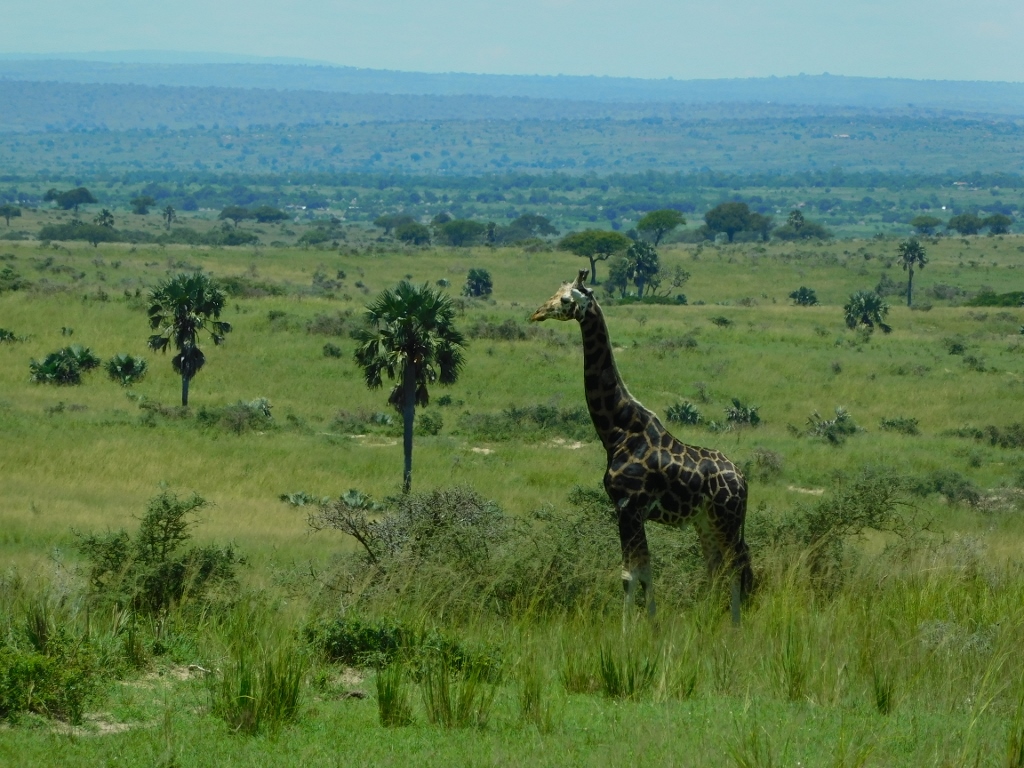 Rothschild’s giraffe
Rothschild’s giraffe
Historically speaking, this giraffe species lived in the area of the park north of the Victoria Nile River, but about a decade ago, several dozen of these giraffes were relocated to the southern part of the national park. The purpose was to allow the population to expand naturally within that territory and to promote tourism development in the region.
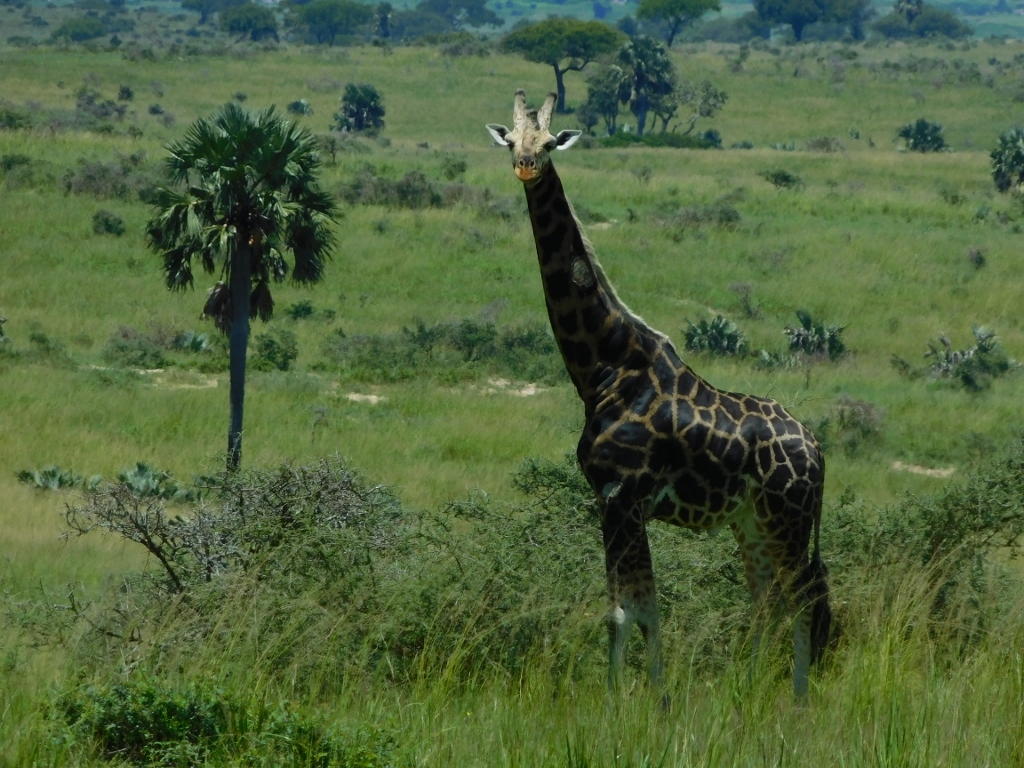 Rothschild’s giraffe
Rothschild’s giraffe
The Rothschild’s giraffe is similar to the Masai giraffe, but the latter only resides in Kenya and Tanzania. Apart from their distinctive skin colour, Rothschild’s giraffes also lack any markings on the lower part of their legs, giving the appearance of wearing white stockings. This is one of the differences from Masai giraffes. This characteristic is clearly visible in the following photograph.
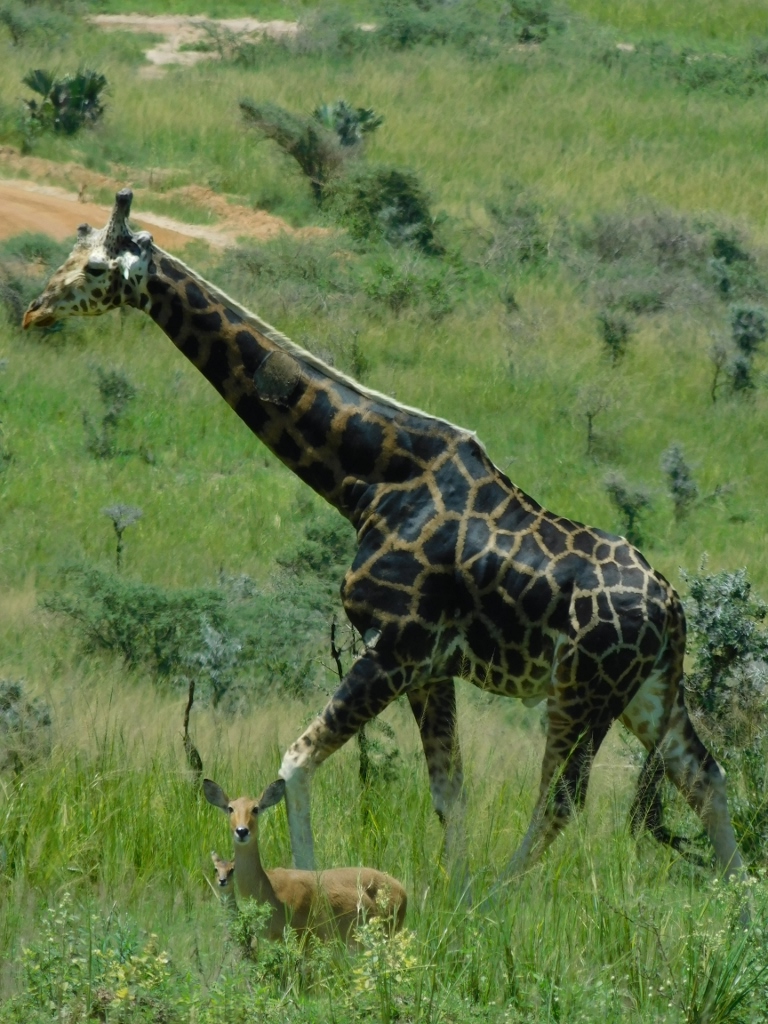 Rothschild’s giraffe
Rothschild’s giraffe
In the photo above, a female of some antelope species with a calf can also be seen. However, I’m not knowledgeable enough to determine whether it’s an impala (Aepyceros melampus), a Ugandan kob antelope (Kobus kob thomasi) or another species. This is a task for experts. Namely, Uganda is home to 29 out of a total of 91 antelope species and while some are easily distinguishable, there are species that bear a resemblance to one another.
There were also smaller oribis and “ordinary” giraffes (Giraffa camelopardalis), including one with a calf.
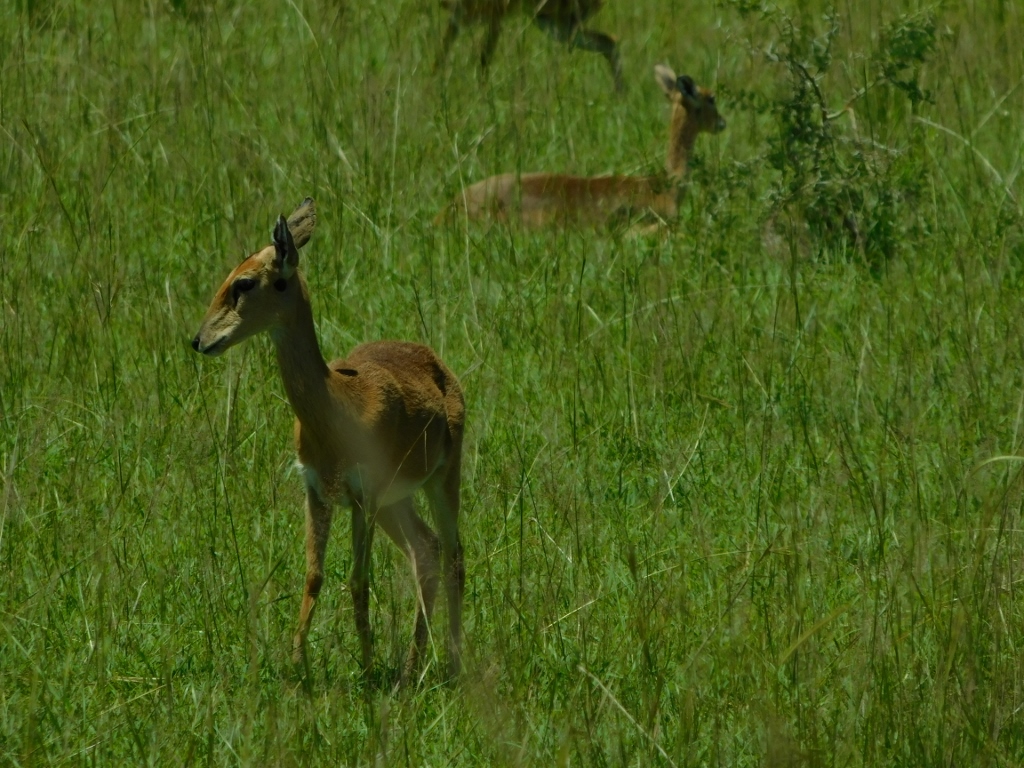 Oribi
Oribi
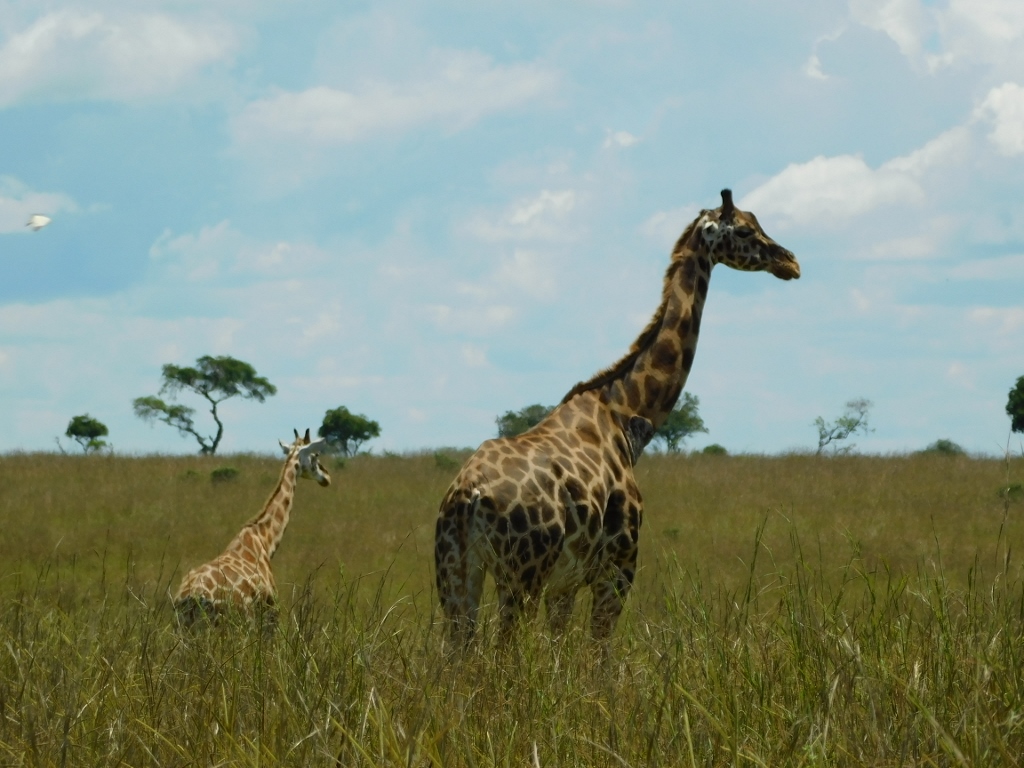 Single mother giraffe and her offspring
Single mother giraffe and her offspring
At one point, we clearly saw the Albert Nile, a segment of the White Nile I have mentioned earlier, flowing out from Lake Albert right at the western boundary of the national park. On the opposite bank of the Albert Nile is the Democratic Republic of the Congo.
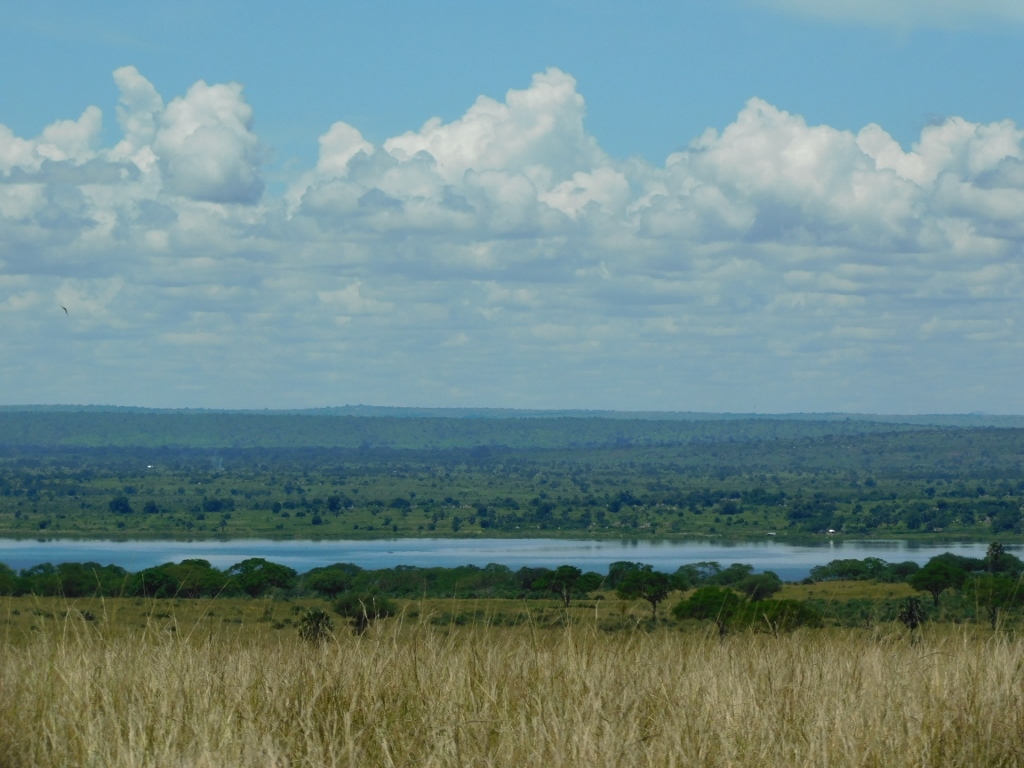 The Albert Nile and the DR Congo
The Albert Nile and the DR Congo
But what constituted the highlight for me, despite enjoying every moment of this wonderful trip, was something our guide spotted in the distance. Initially, we weren’t sure if it was real, but it turned out to be true – it was a leopard (Panthera pardus) and it was in a tree. Since the tree was quite far from us, I used the zoom, but I wasn’t at all sure what I managed to capture and how. It was only when I returned home that I saw there was fresh prey on the tree behind the leopard. Clearly, this was one psychologically healthy and stable leopard, fully aware of the “delayed gratification” concept, so the kill calmly awaited behind him its turn to be consumed.
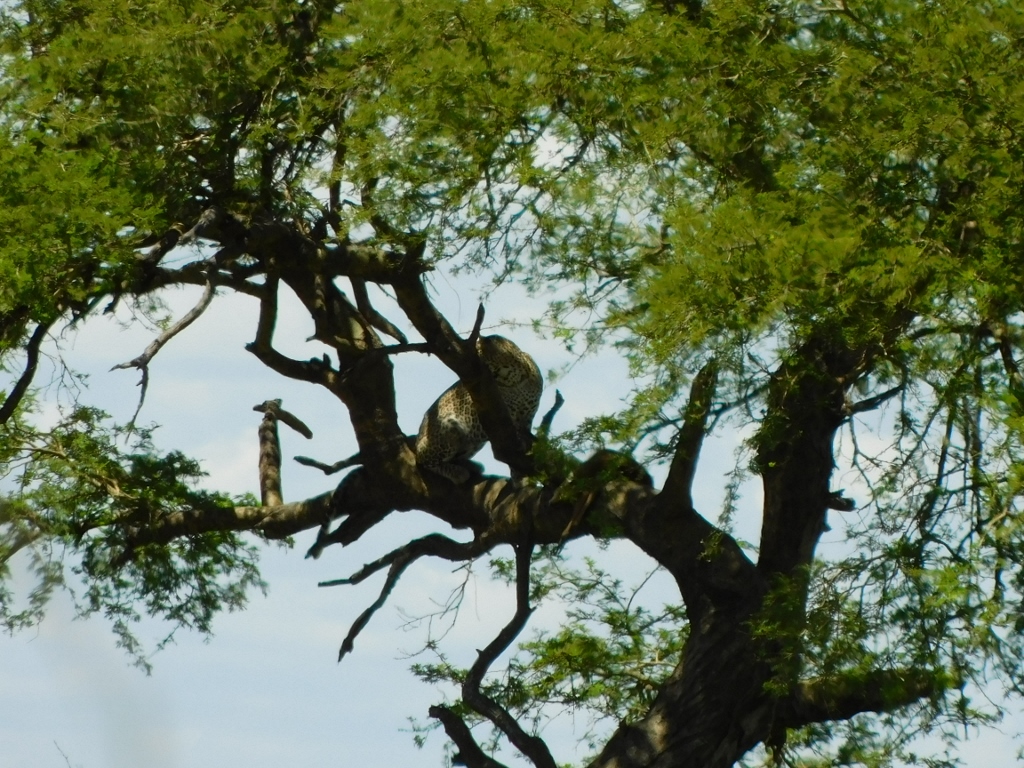 Leopard in a tree canopy
Leopard in a tree canopy
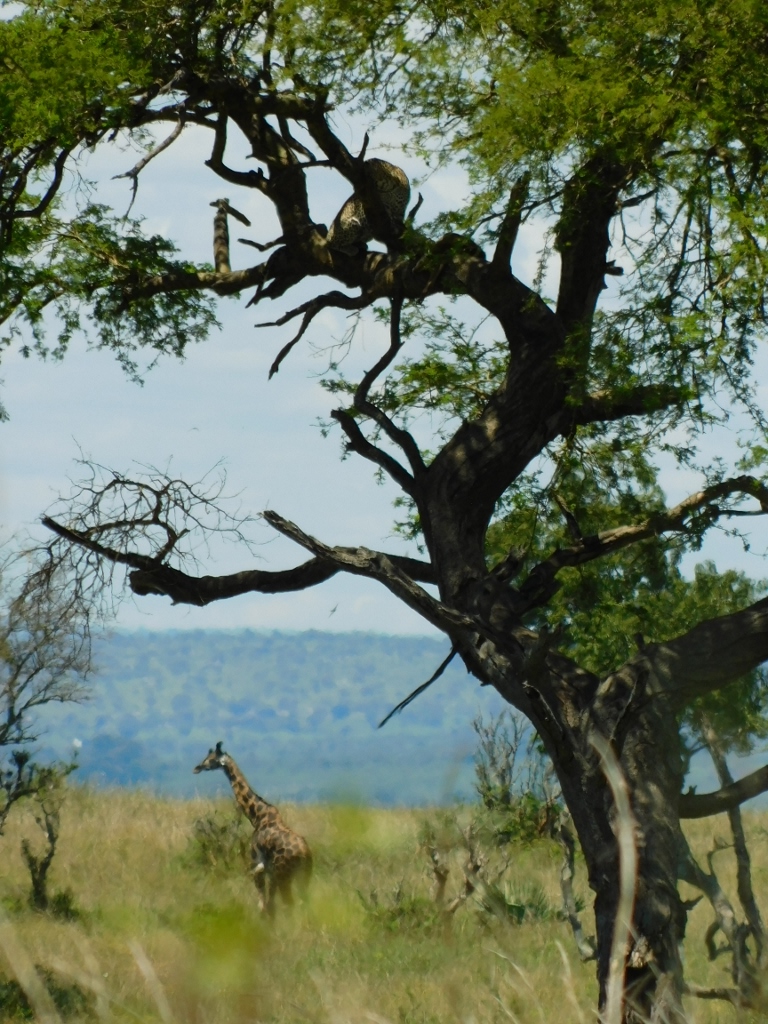 Leopard in a tree canopy
Leopard in a tree canopy
While I was readjusting to take more photos, the leopard changed its position, now lying comfortably on a branch with its back turned towards us.
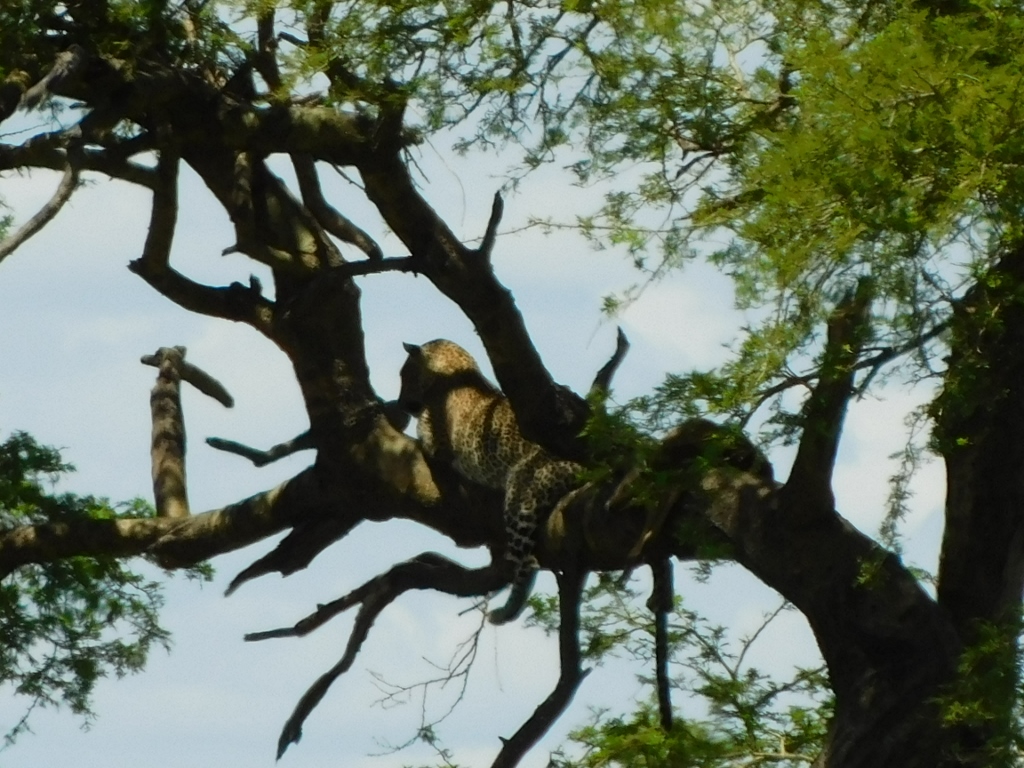 Leopard in a tree canopy
Leopard in a tree canopy
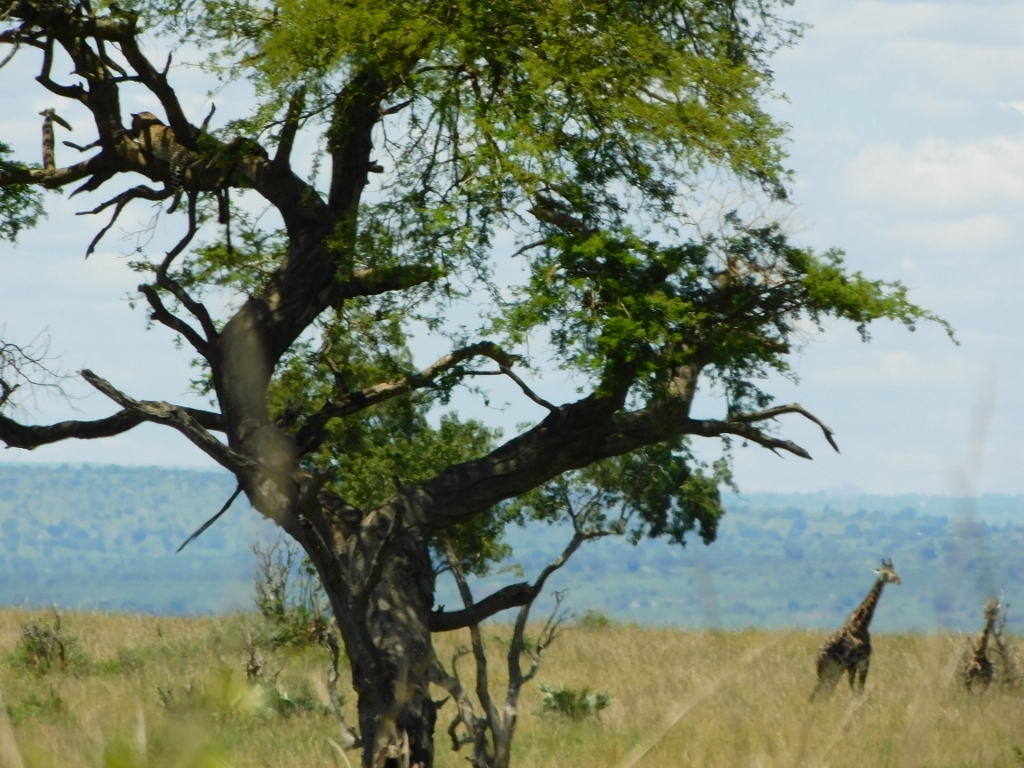 Leopard in a tree canopy
Leopard in a tree canopy
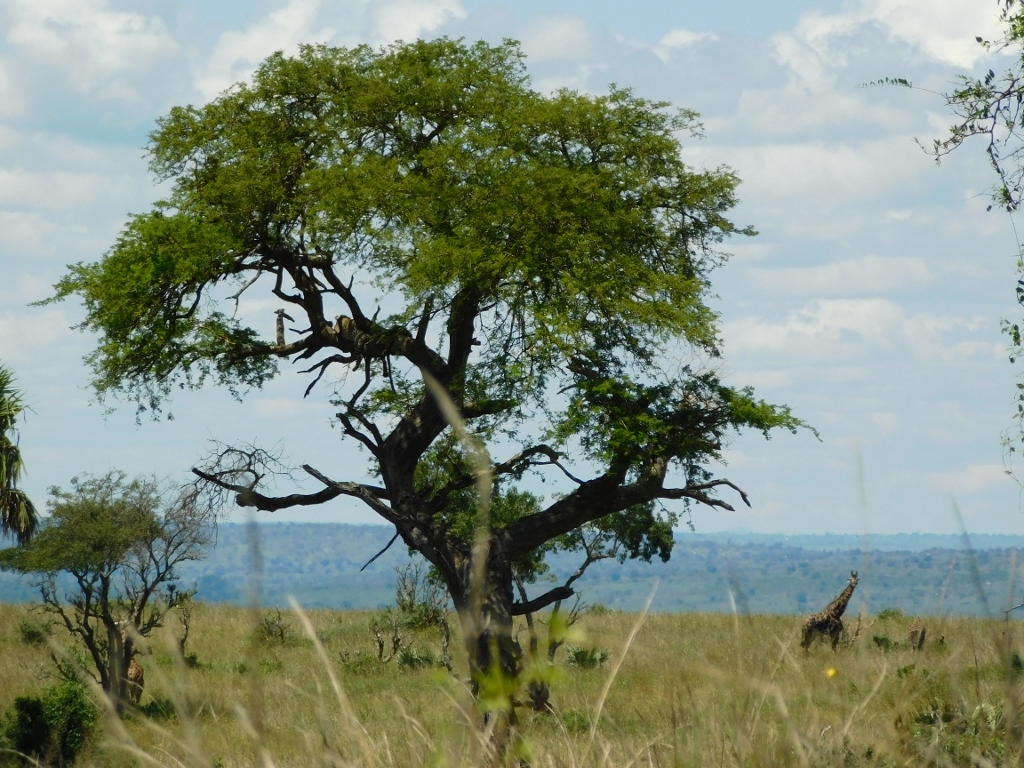 Leopard in a tree canopy
Leopard in a tree canopy
As it can be seen in the previous photos, I kept adjusting the zoom to capture different details, and then I zoomed in again on the leopard. I was very happy when I returned home and saw on the computer what I had actually captured.
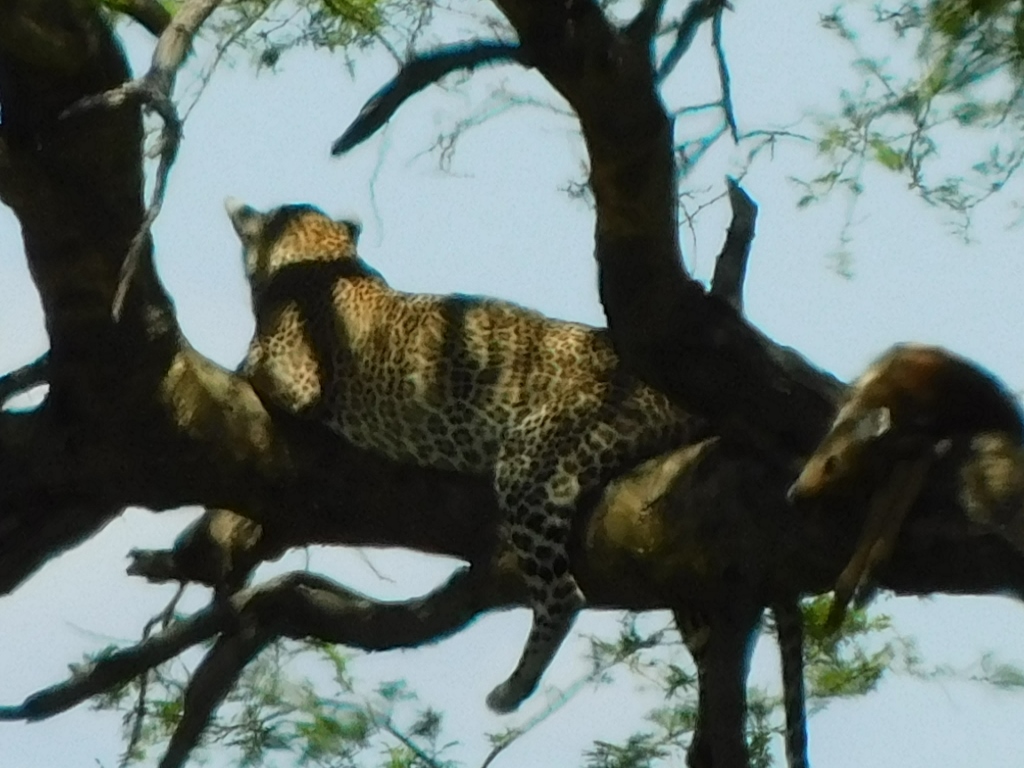 Leopard in a tree canopy
Leopard in a tree canopy
I even managed to capture a short video. Again, I didn’t have anything to stabilise my camera on, so the footage is a bit shaky, but I’m still absolutely satisfied.
After this pause to take photos of the leopard in the distance, we moved a bit with the vehicle and then stopped again to film Ugandan kobs (Kobus kob thomasi). We often encountered them here as they are abundant, but I hadn’t managed to capture them well before. The male Ugandan kob is featured on the national coat of arms, making this species an important symbol of Uganda.
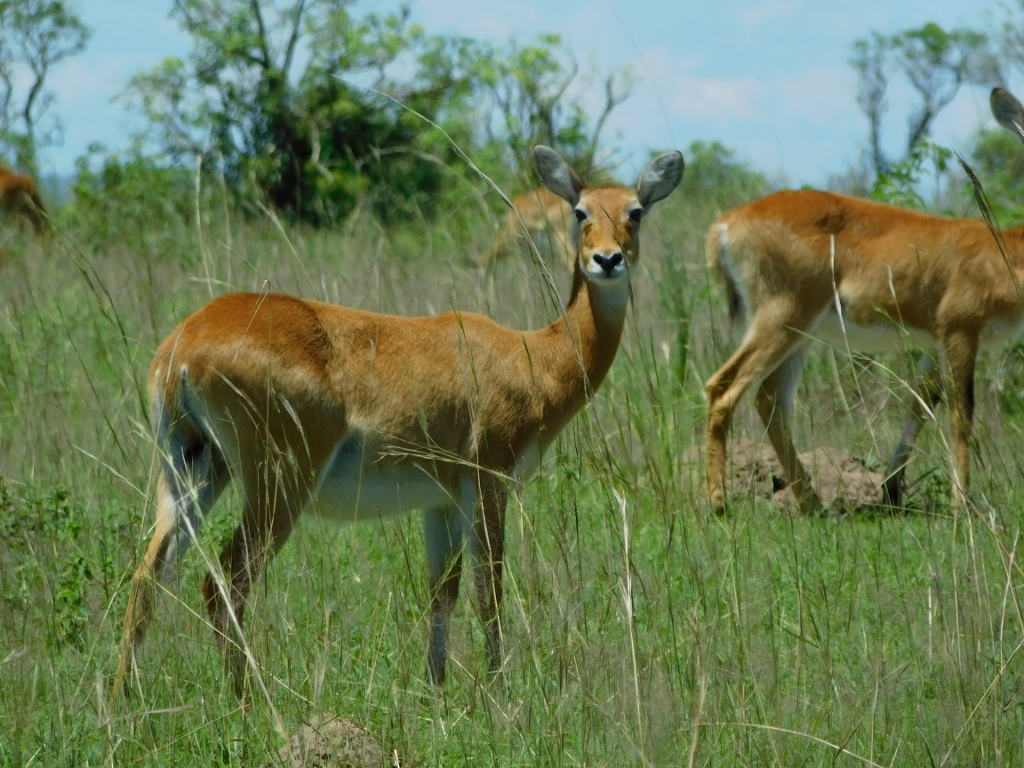 Female Ugandan kobs
Female Ugandan kobs
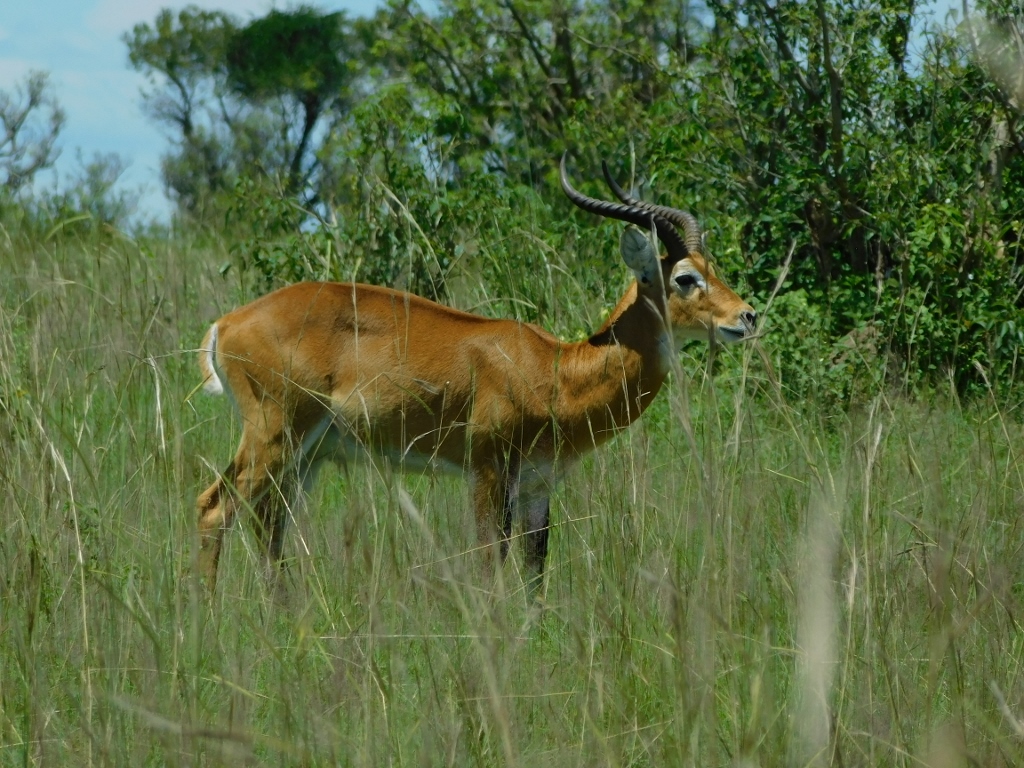 Male Ugandan kob
Male Ugandan kob
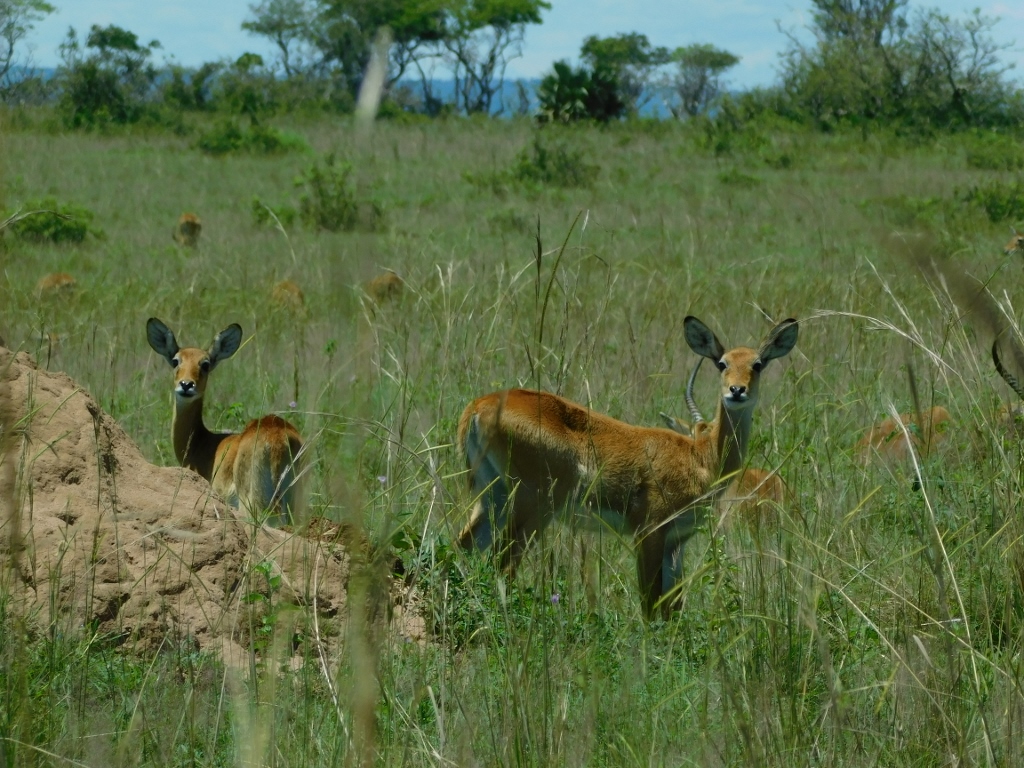 Female Ugandan kobs
Female Ugandan kobs
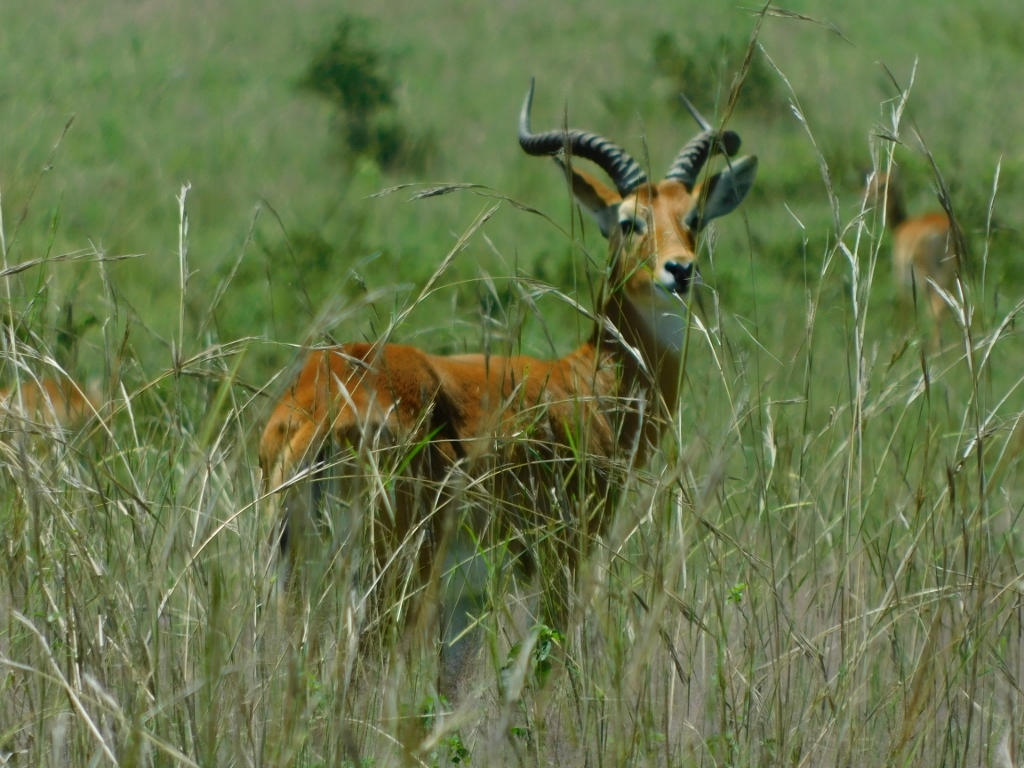 Male Ugandan kob
Male Ugandan kob
Although I spotted some smaller and quite colourful, hence easily noticeable birds along the way, I couldn’t manage to take photos of them. Therefore, I was very pleased when I saw and captured an African grey hornbill (Lophoceros nasutus).
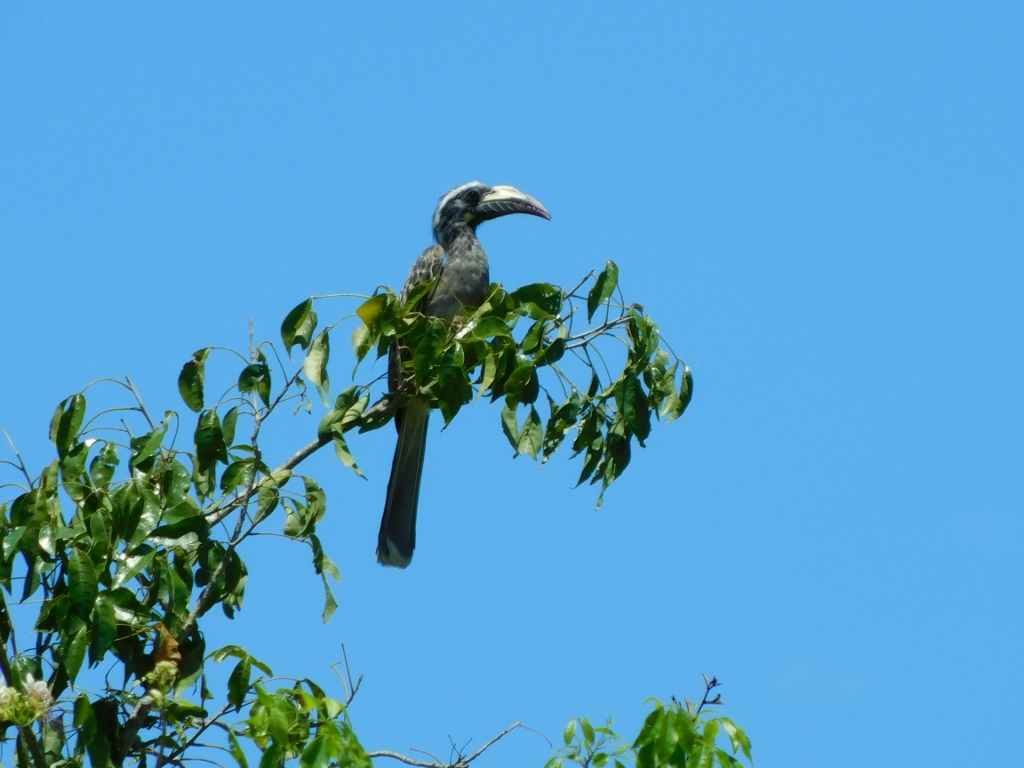 African grey hornbill
African grey hornbill
Then we arrived at a large clearing where, in the distance, we could see African buffaloes, occasional giraffes and various small antelopes.
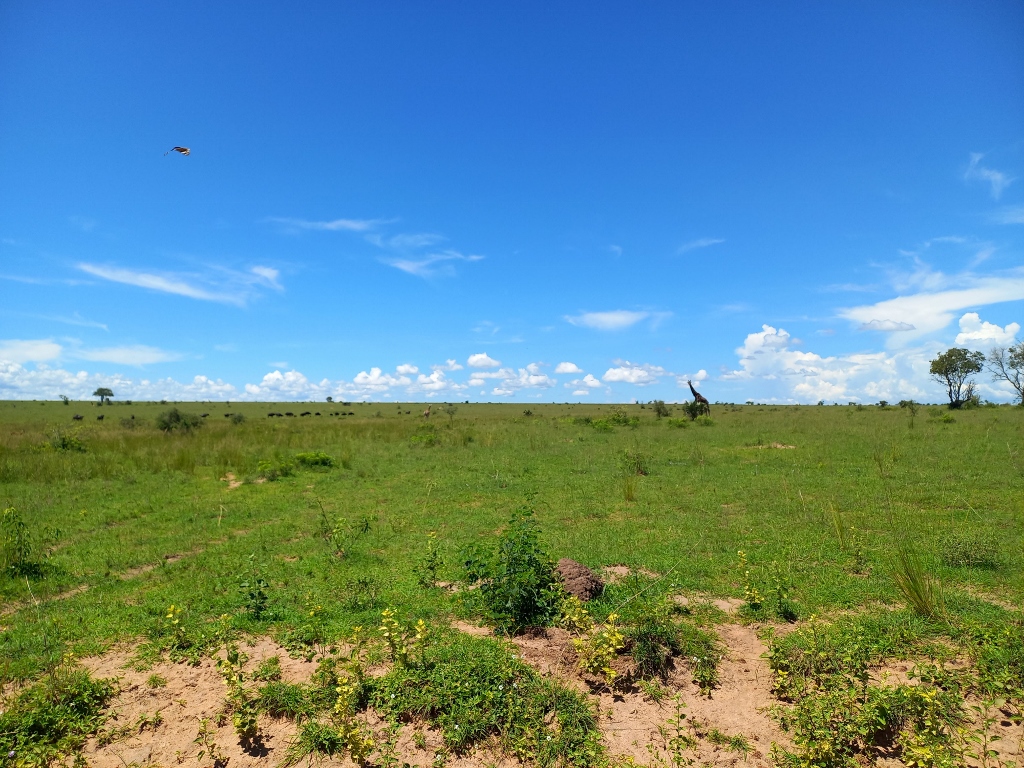 Murchison Falls NP
Murchison Falls NP
While we were standing there to observe the landscape and animals, one giraffe passed quite close, allowing me to capture it nicely.
At one point, it even stopped and posed nicely, looking towards us. Judging by the white stockings, this was a Rothschild’s giraffe.
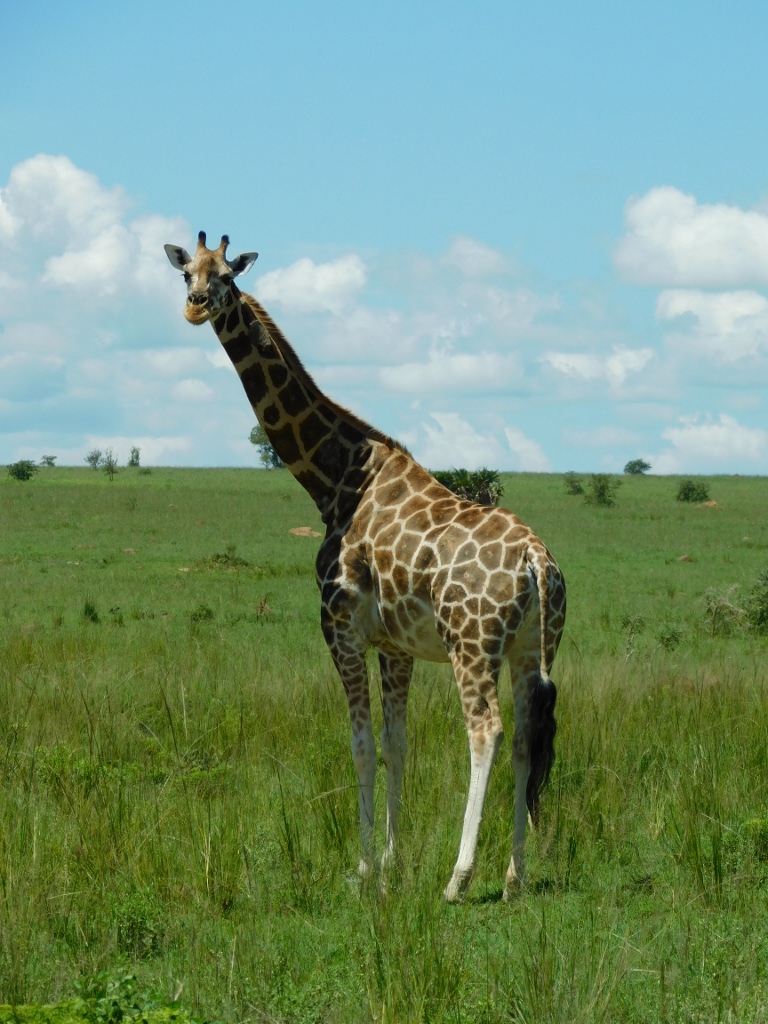 Rothschild’s giraffe
Rothschild’s giraffe
Then, it turned its back and continued moving across the savanna, while African buffaloes in the distance observed it all.
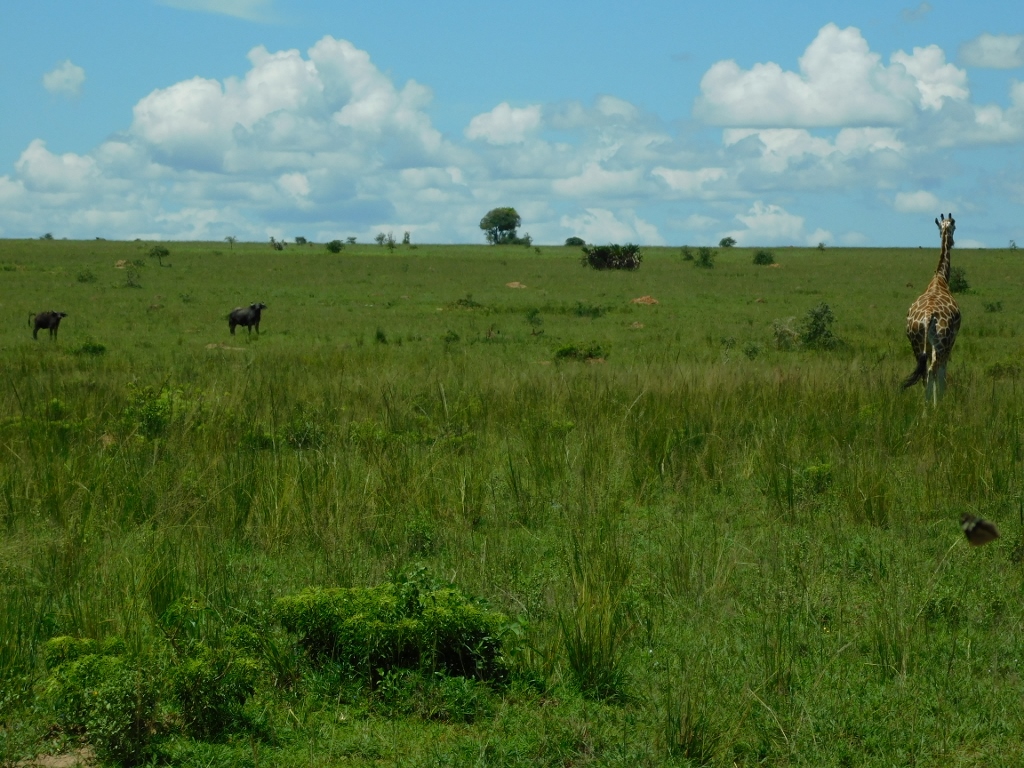 African buffalos and a giraffe
African buffalos and a giraffe
Now comes a series of three photos depicting the same animals, but the photos are interesting because they show birds flying down to the giraffe and landing on its neck, as they need to clean the giraffe from parasites.
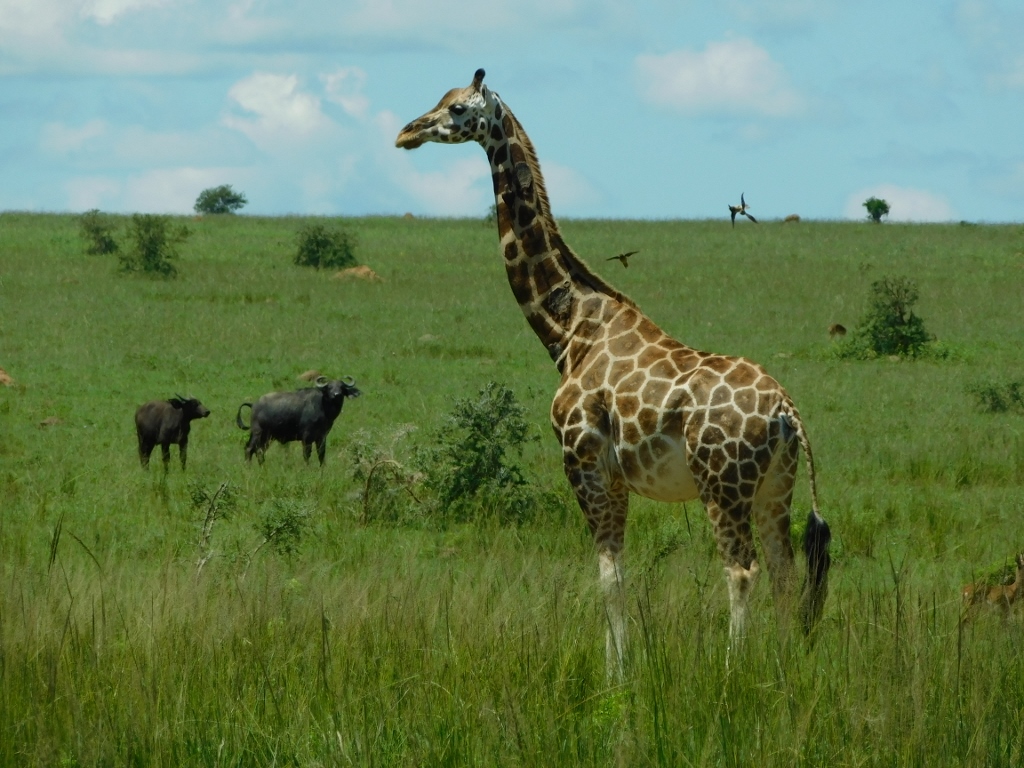 African buffalos, the giraffe and small birds
African buffalos, the giraffe and small birds
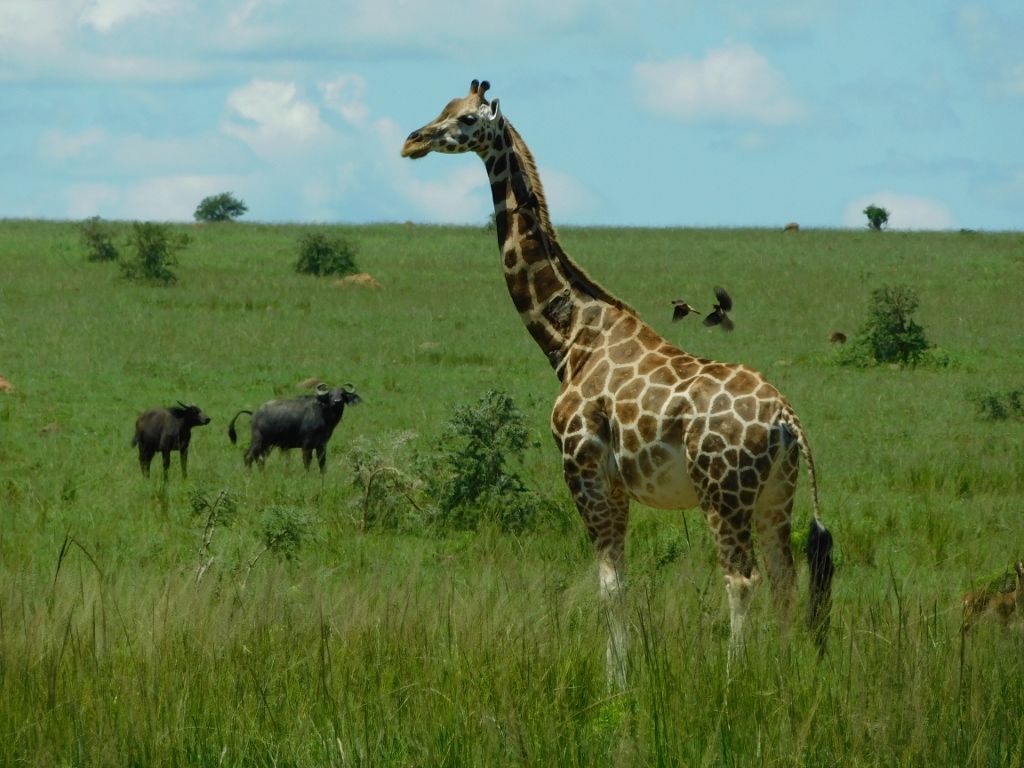 African buffalos, the giraffe and small birds
African buffalos, the giraffe and small birds
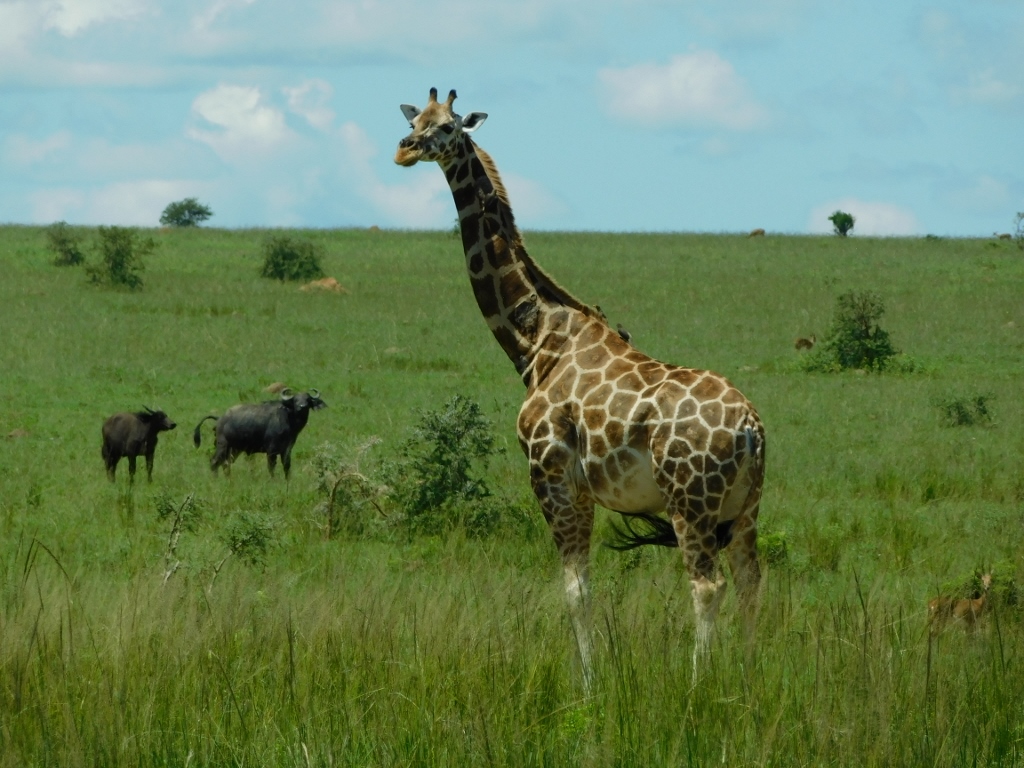 African buffalos, the giraffe and small birds
African buffalos, the giraffe and small birds
But, if two birds landed on this giraffe, what can be said about another one – a male Rothschild’s giraffe (from what I’ve read, males are usually darker than females) that was also moving nearby and whose entire back and neck were covered with birds. By the way, these birds belong to the yellow-billed oxpecker species (Buphagus africanus).
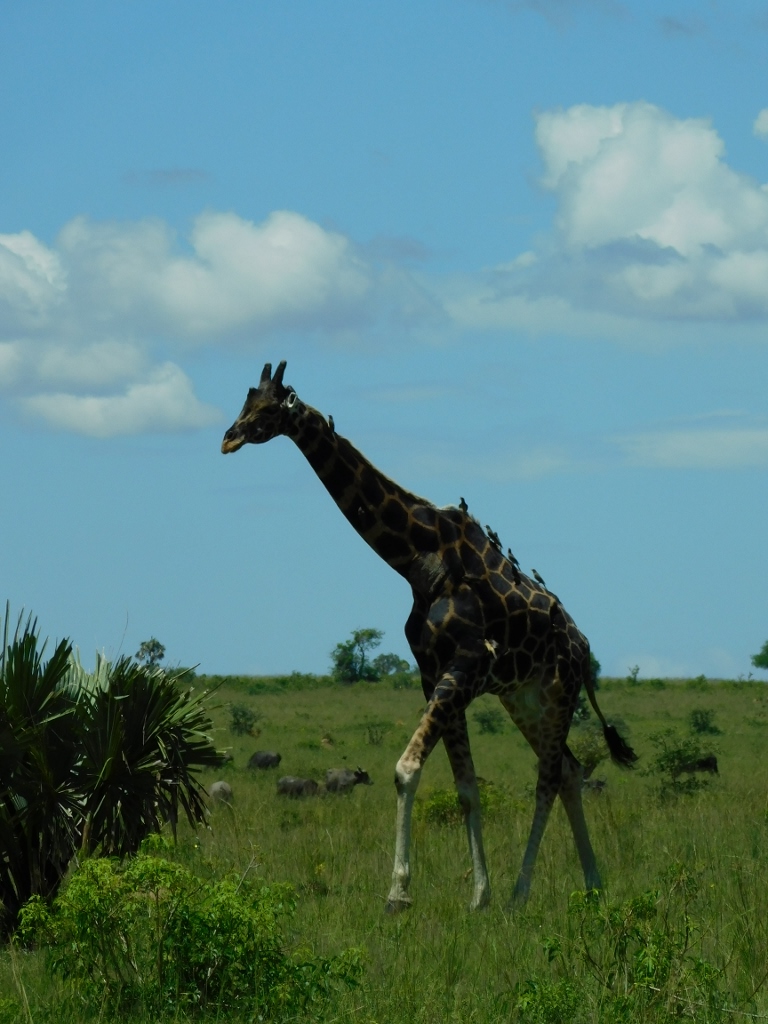 Rothschild’s giraffe and yellow-billed oxpeckers
Rothschild’s giraffe and yellow-billed oxpeckers
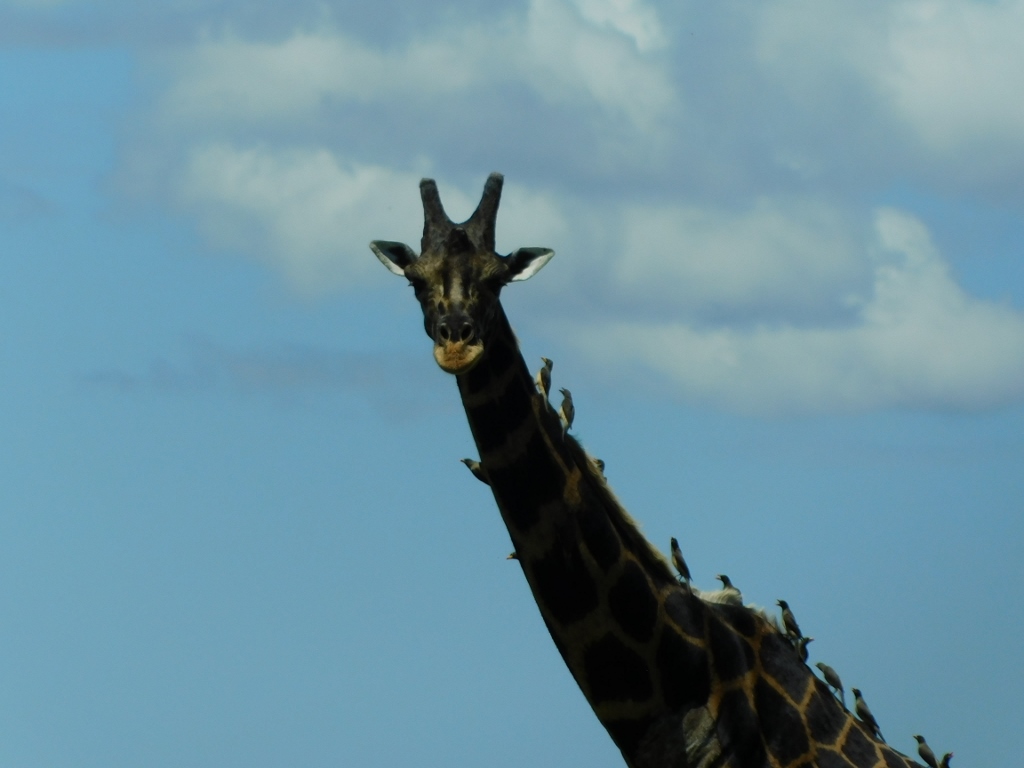 Rothschild’s giraffe and yellow-billed oxpeckers
Rothschild’s giraffe and yellow-billed oxpeckers
The next two photos bring the giraffe’s head even closer, but besides that, both photos are particularly interesting for specific reasons. In the first one, in addition to the giraffe and the birds, tiny insects flying around the giraffe’s head (poor thing) can also be seen.
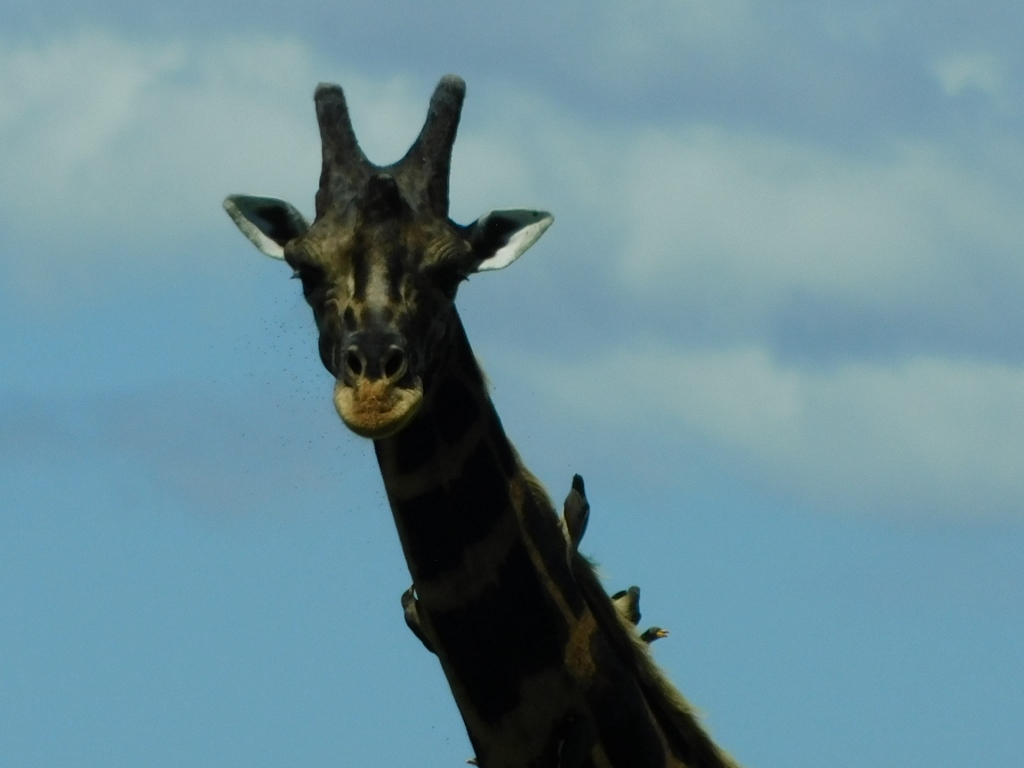 Rothschild’s giraffe and yellow-billed oxpeckers
Rothschild’s giraffe and yellow-billed oxpeckers
In that same photo and even more in the next one, another characteristic of the Rothschilds giraffe is visible. Namely, these are the only giraffes that have five ossicones – two on the top of the head, which all other giraffes also have, one in the middle of the forehead (and this is what can be clearly seen in the photos) and two behind the ears.
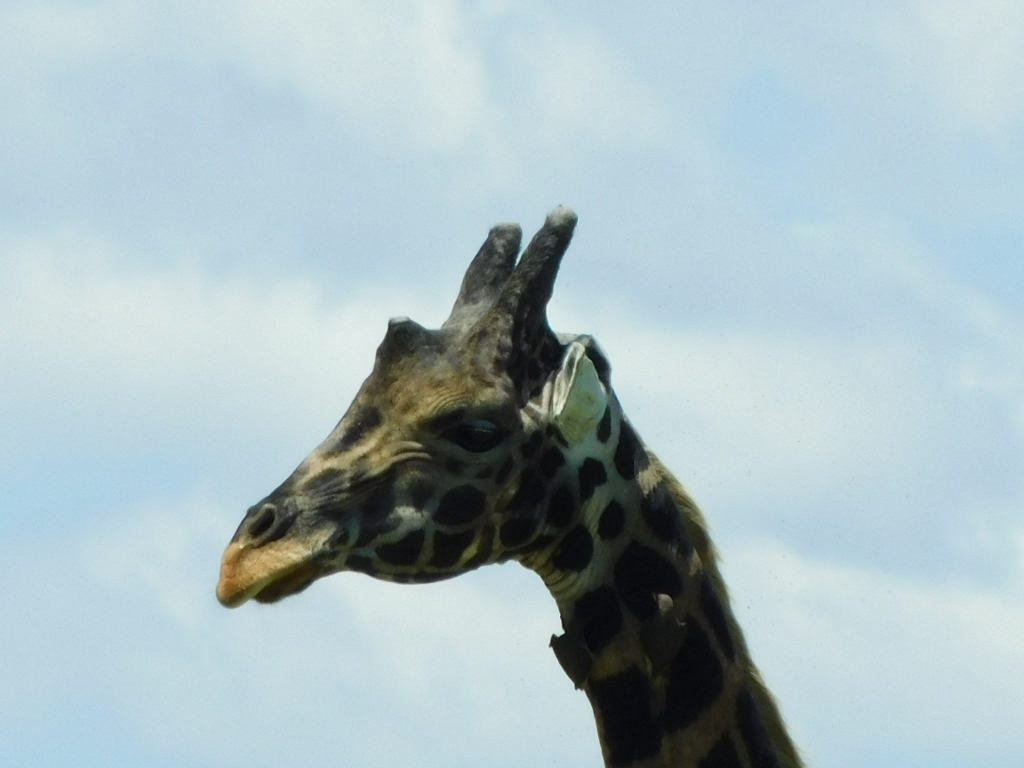 Rothschild’s giraffe
Rothschild’s giraffe
This giraffe species is also among the taller ones – it can grow up to a height of 5.9 meters, while its weight can exceed one ton. Of course, due to this height, giraffes can easily feed on leaves from the tops of trees.
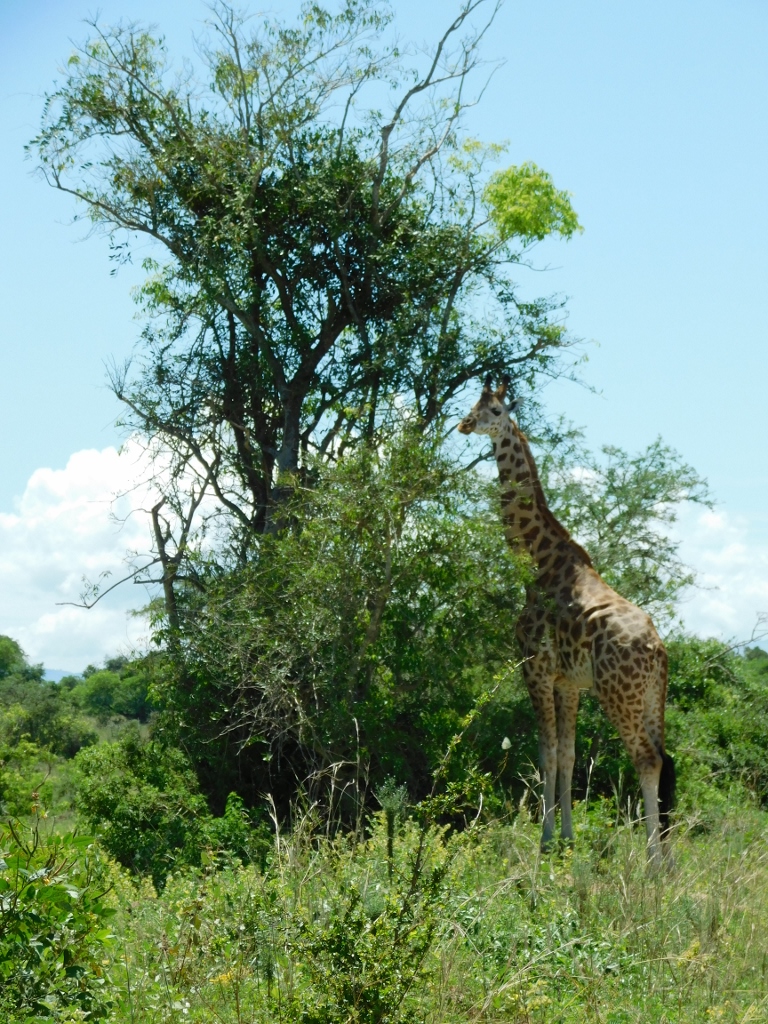 Giraffe
Giraffe
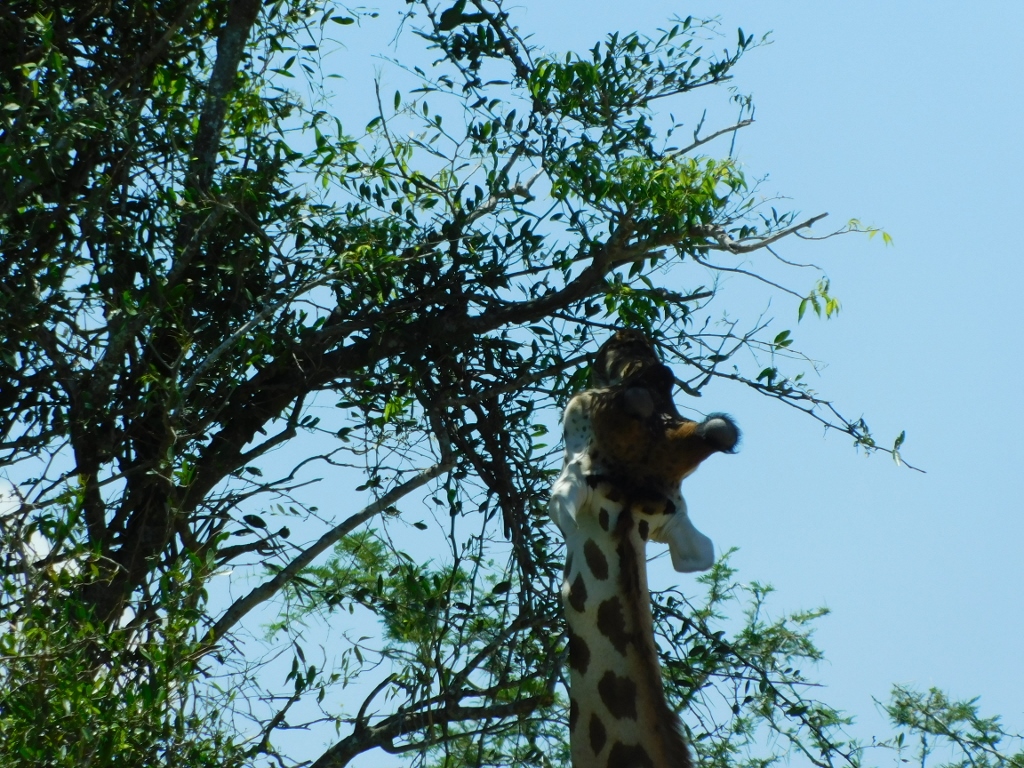 Giraffe in the middle of a lunch
Giraffe in the middle of a lunch
However, giraffes don’t complain even when the leaves are somewhat lower.
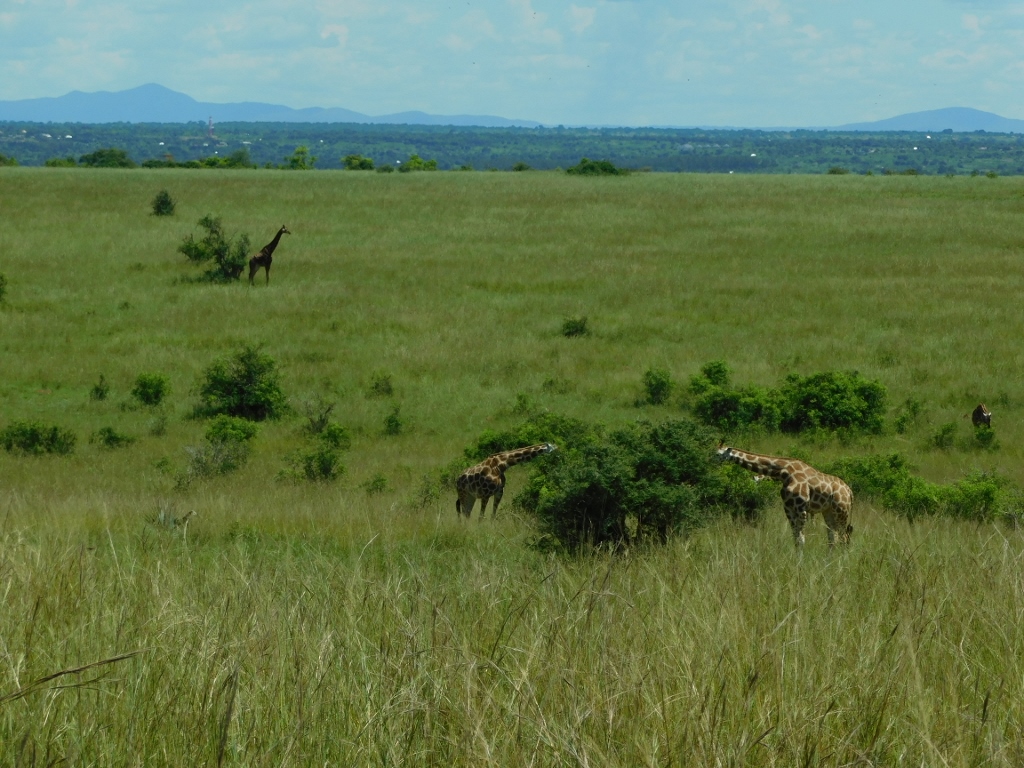 Giraffes in the Murchison Falls NP
Giraffes in the Murchison Falls NP
On this day, the giraffes were more visible than other animals and we mostly spotted them on the savanna. However, at one point, we descended to the banks of the delta of the Victoria Nile, where it flows into Lake Albert. This way, we reached the river habitat within the national park.
 Part of the Victoria Nile delta
Part of the Victoria Nile delta
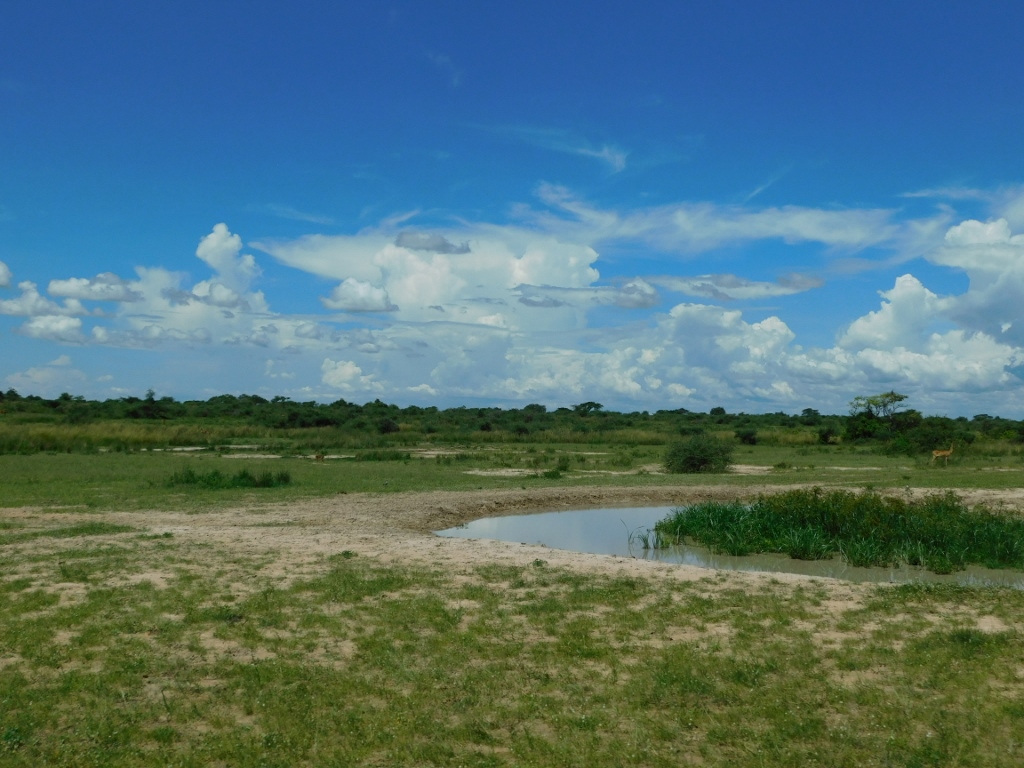 Part of the Victoria Nile delta
Part of the Victoria Nile delta
I found it particularly interesting here to see not only the course of the Albert Nile, that is already flowing northward, but also parts of the Democratic Republic of the Congo.
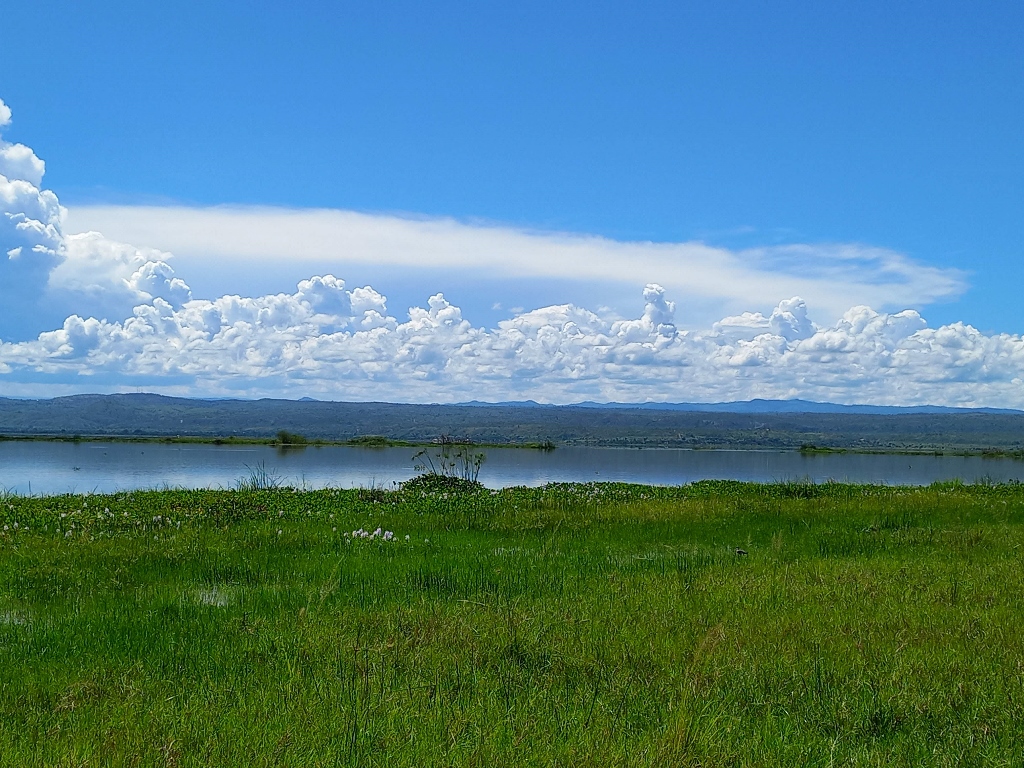 The Albert Nile and the DR Congo
The Albert Nile and the DR Congo
There were also local fishermen doing their job.
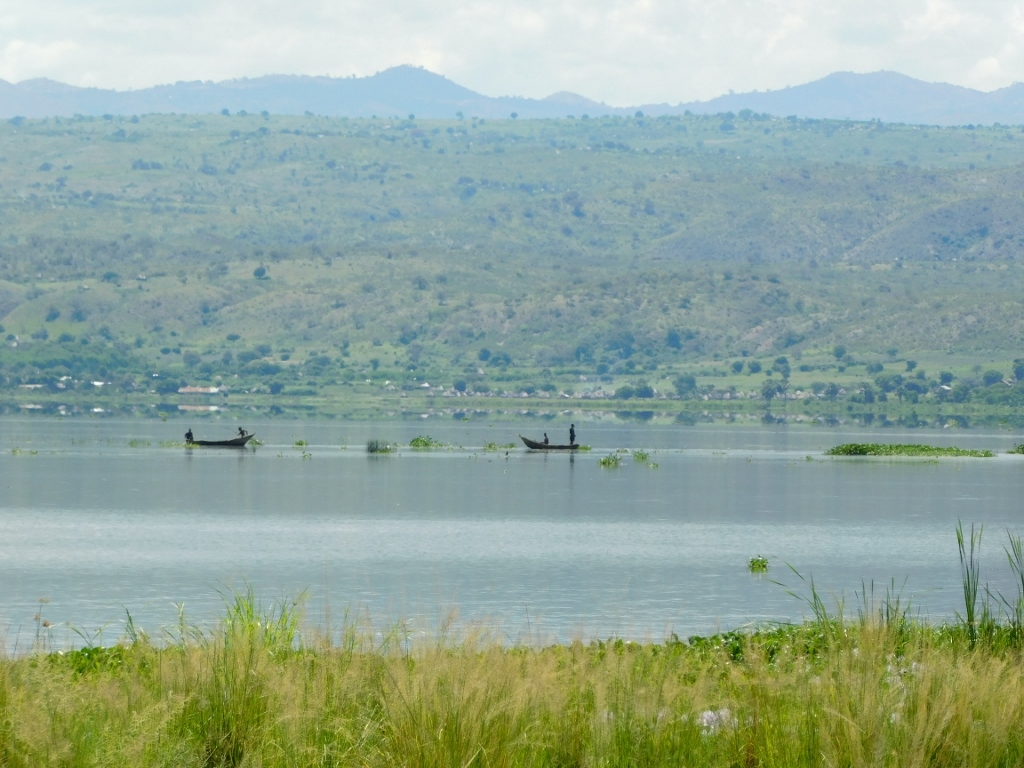 Fishermen at the Albert Nile
Fishermen at the Albert Nile
However, I was still mostly interested in animals. When we arrived here, the first one we came across was a spur-winged lapwing (Vanellus spinosus).
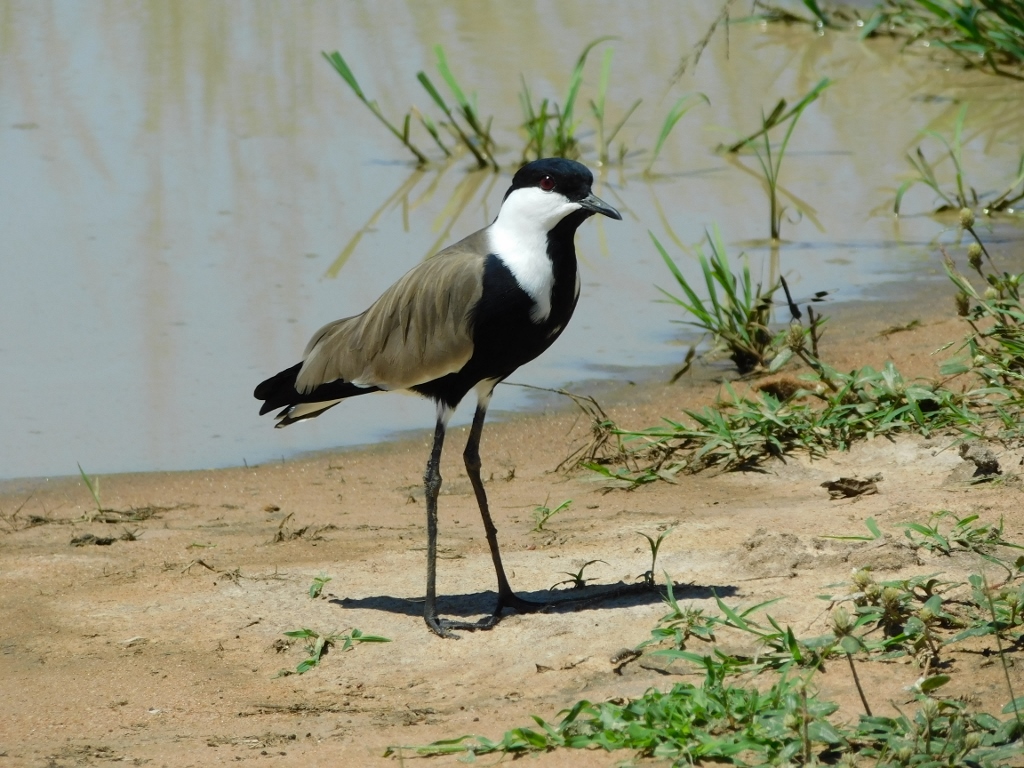 Spur-winged lapwing
Spur-winged lapwing
But, there were still plenty of giraffes and antelopes in the vicinity.
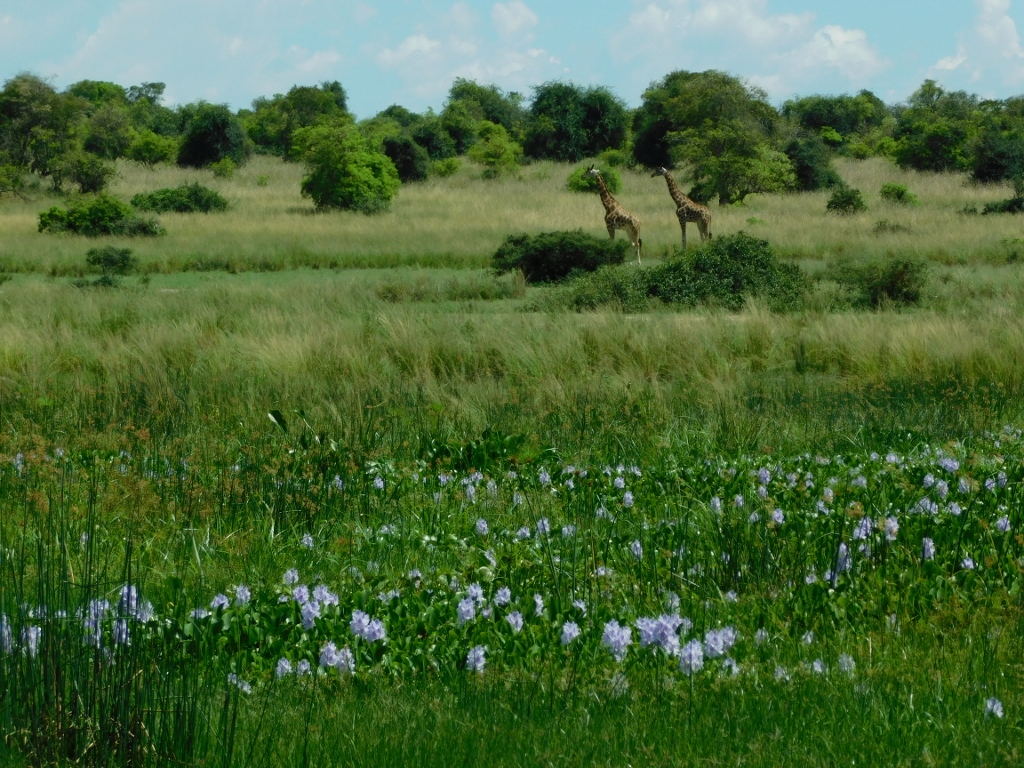 Giraffes near the Victoria Nile delta
Giraffes near the Victoria Nile delta
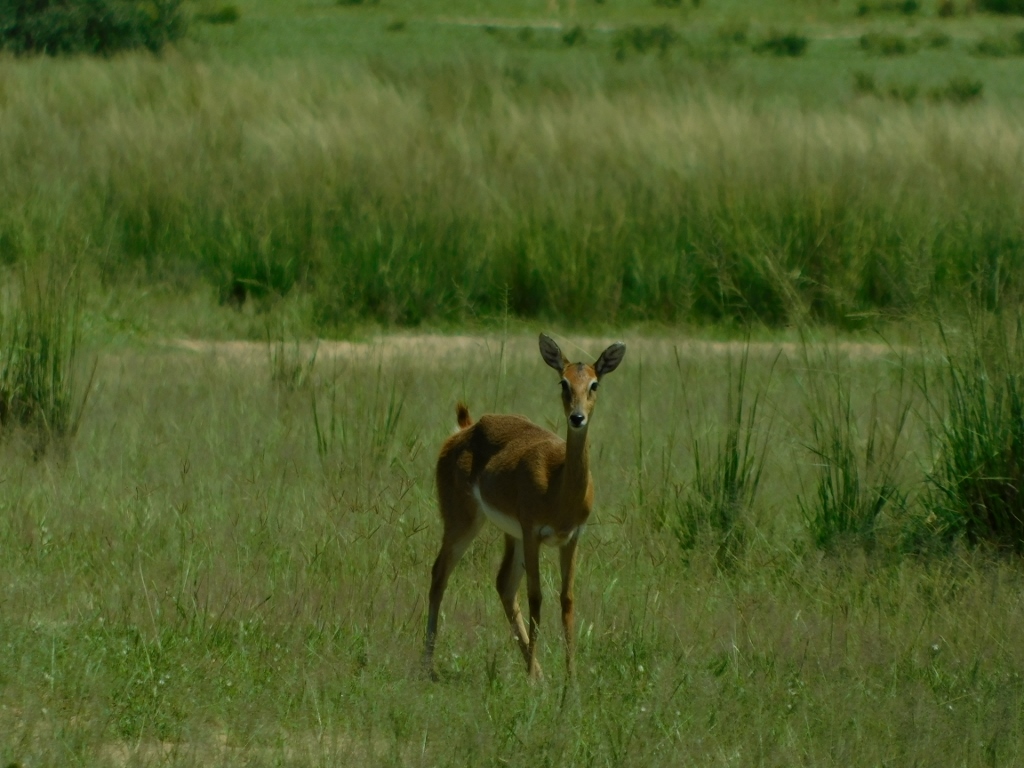 Antelope near the Victoria Nile delta
Antelope near the Victoria Nile delta
A bit further, tucked into the water, I saw and took photos of a hippopotamus (Hippopotamus amphibius) and a common sandpiper (Actitis hypoleucos) standing on its back. In second picture, they are accompanied by a dragonfly that has landed on the head of the hippo.
 A hippo and a common sandpiper
A hippo and a common sandpiper
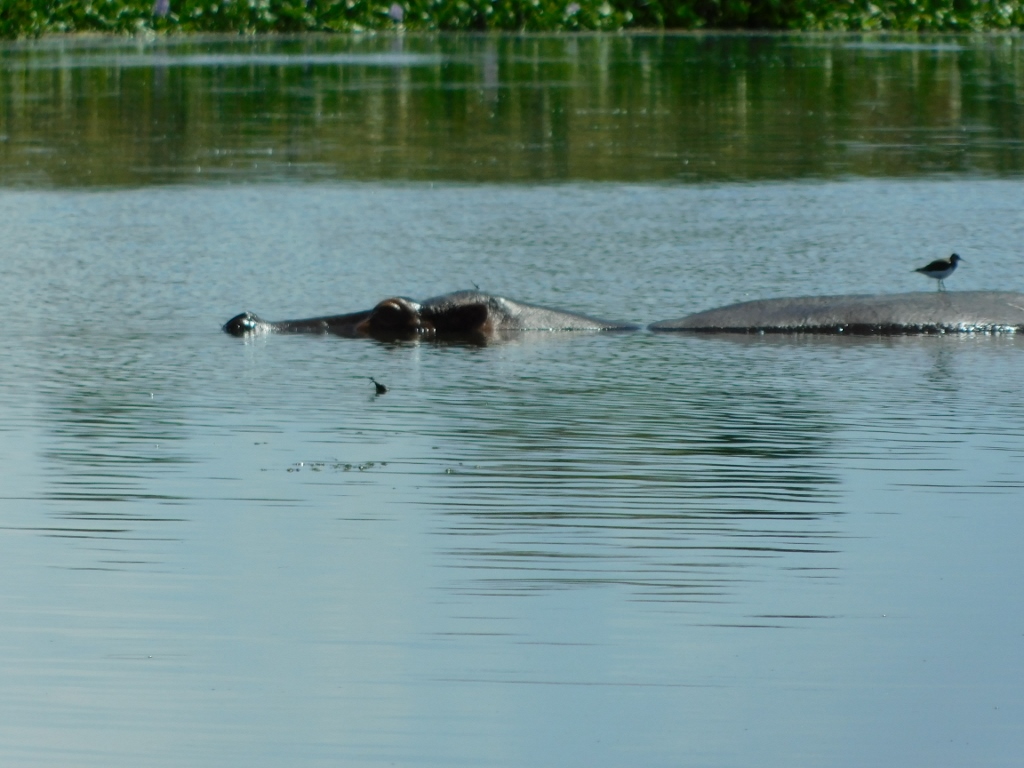 A hippo, a common sandpiper and a dragonfly
A hippo, a common sandpiper and a dragonfly
Here, we could take a short walk, but there was also a built structure serving as a toilet. For me, the most interesting part was once again observing and capturing animals. For instance, I spotted a lizard that I believe is a female rainbow agama lizard (*Agama agama). My companions also pointed out a couple of bats peeking from their hiding place in the roof of that small house.
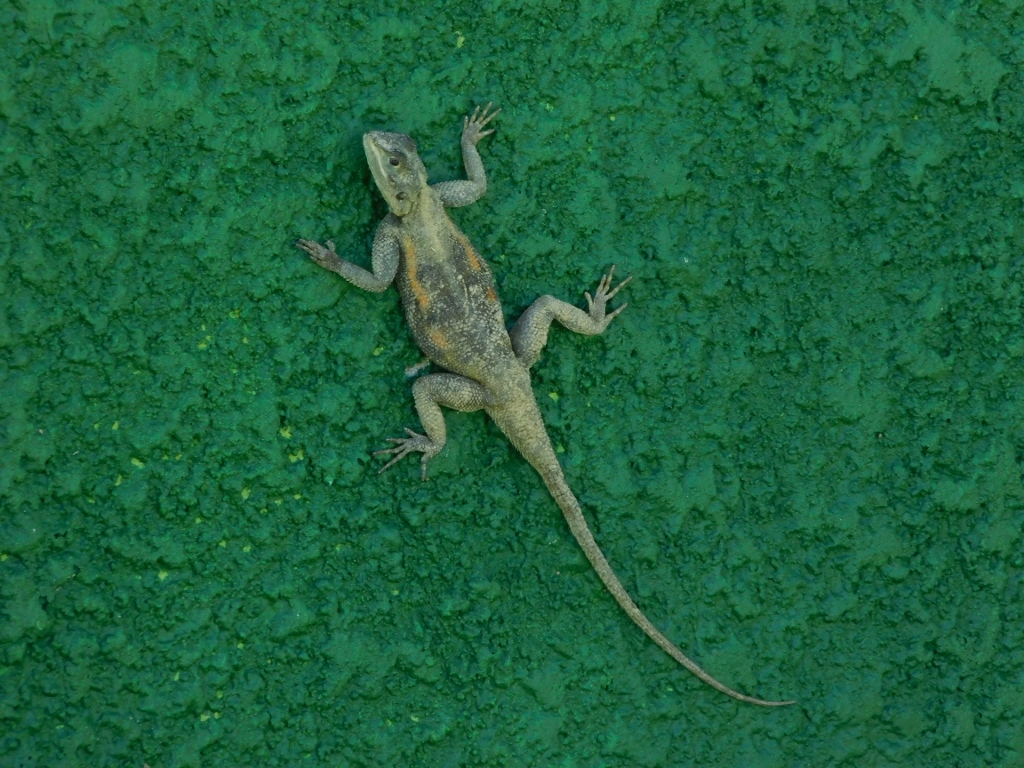 Lizard on the wall of the shed
Lizard on the wall of the shed
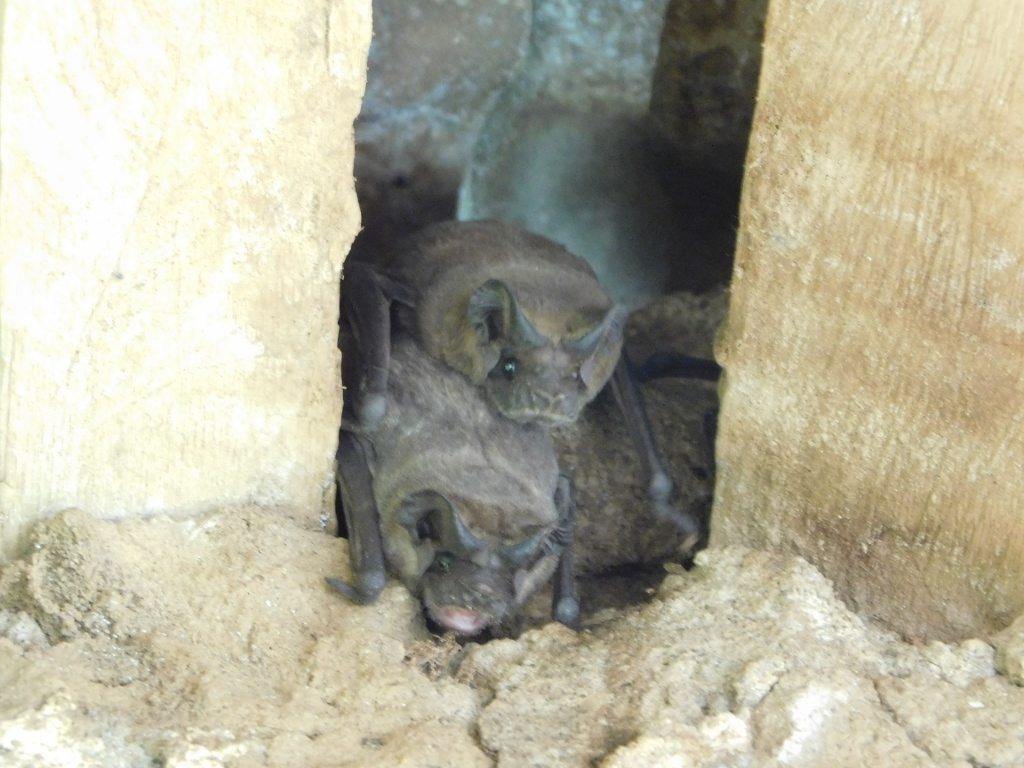 Bats in the roof of the shed
Bats in the roof of the shed
In front of the shed, there was also a wooden tower and there, a female and male red-cheeked cordonbleus (Uraeginthus bengalus) posed nicely for me.
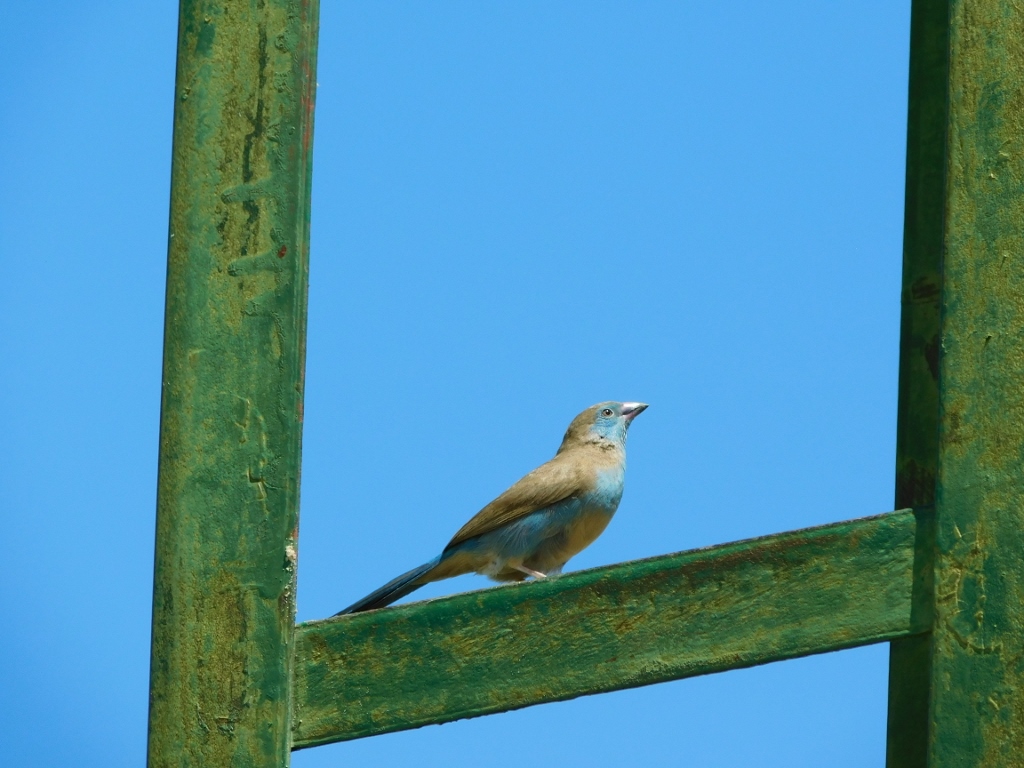 Female red-cheeked cordonbleu
Female red-cheeked cordonbleu
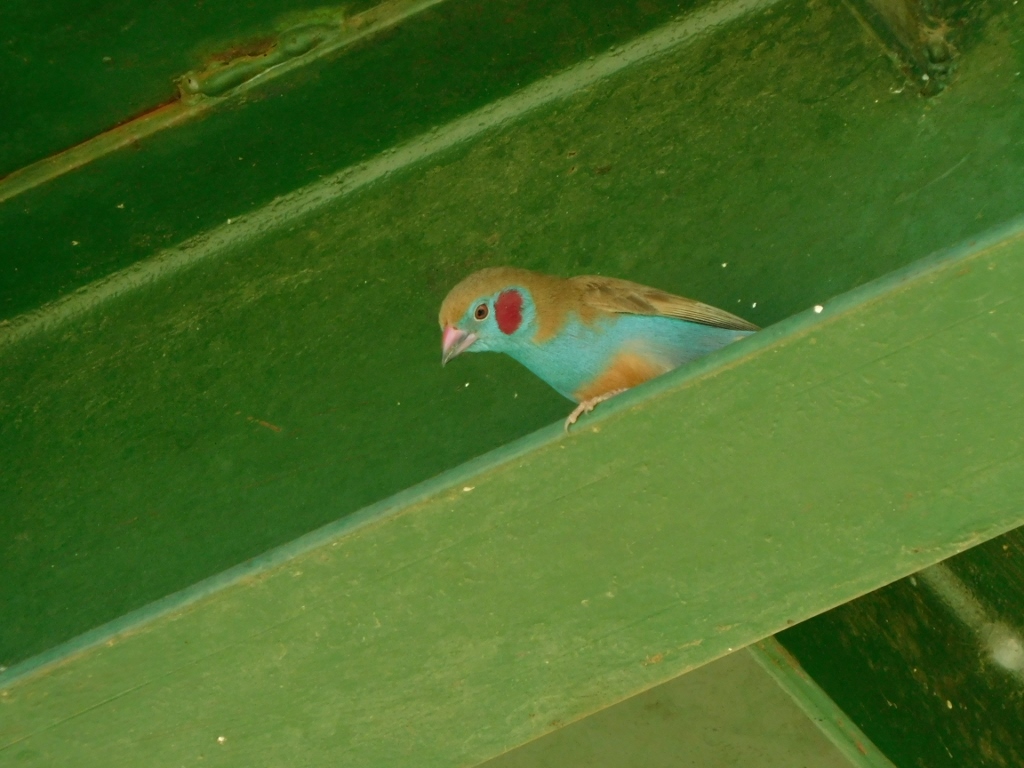 Male red-cheeked cordonbleu
Male red-cheeked cordonbleu
After this break, we practically started making our way back towards the exit from the national park. I was extremely satisfied, but not any less keen on observing the surroundings.
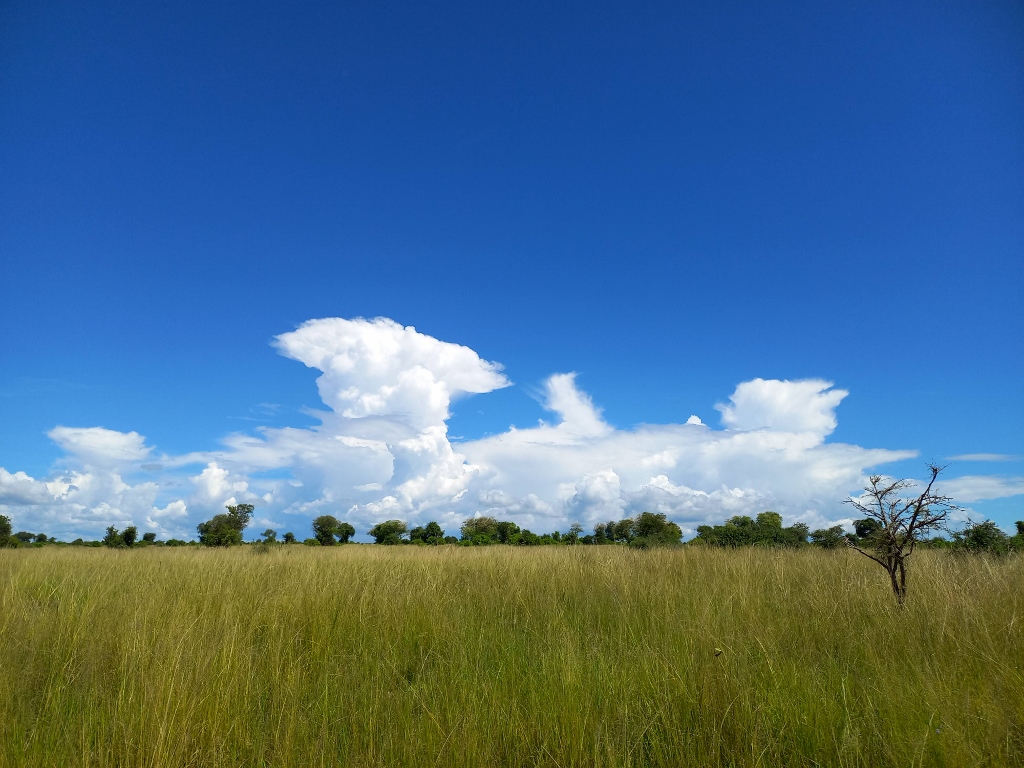 Murchison Falls NP
Murchison Falls NP
Once again, we frequently encountered Ugandan kobs.
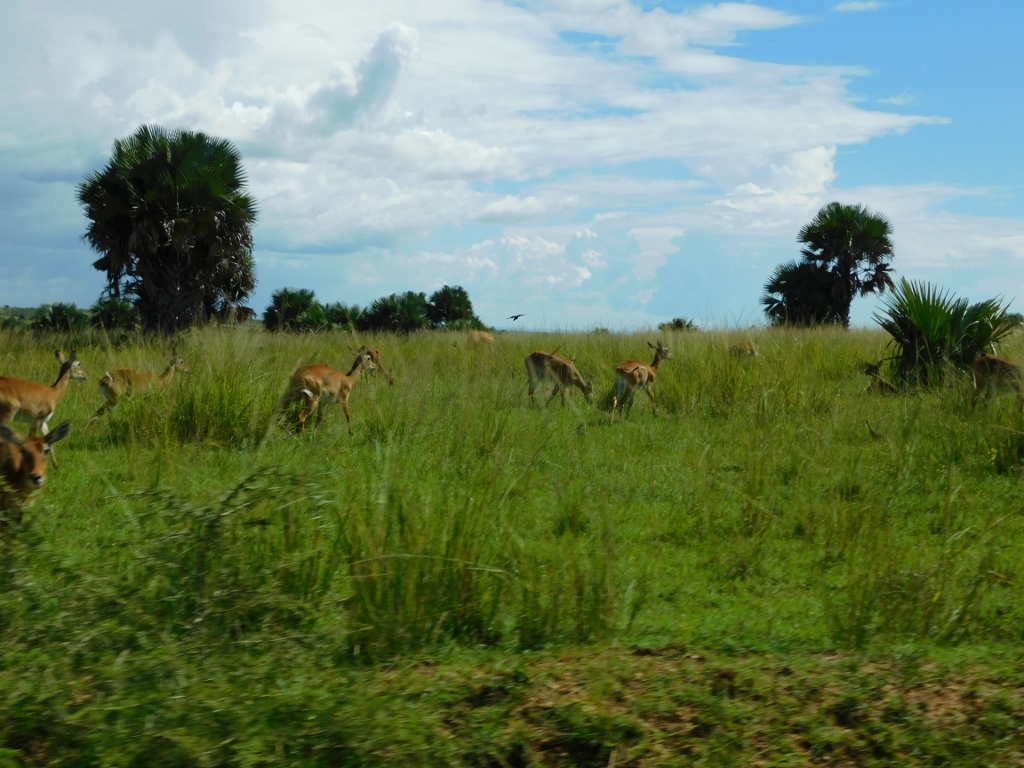 Murchison Falls NP
Murchison Falls NP
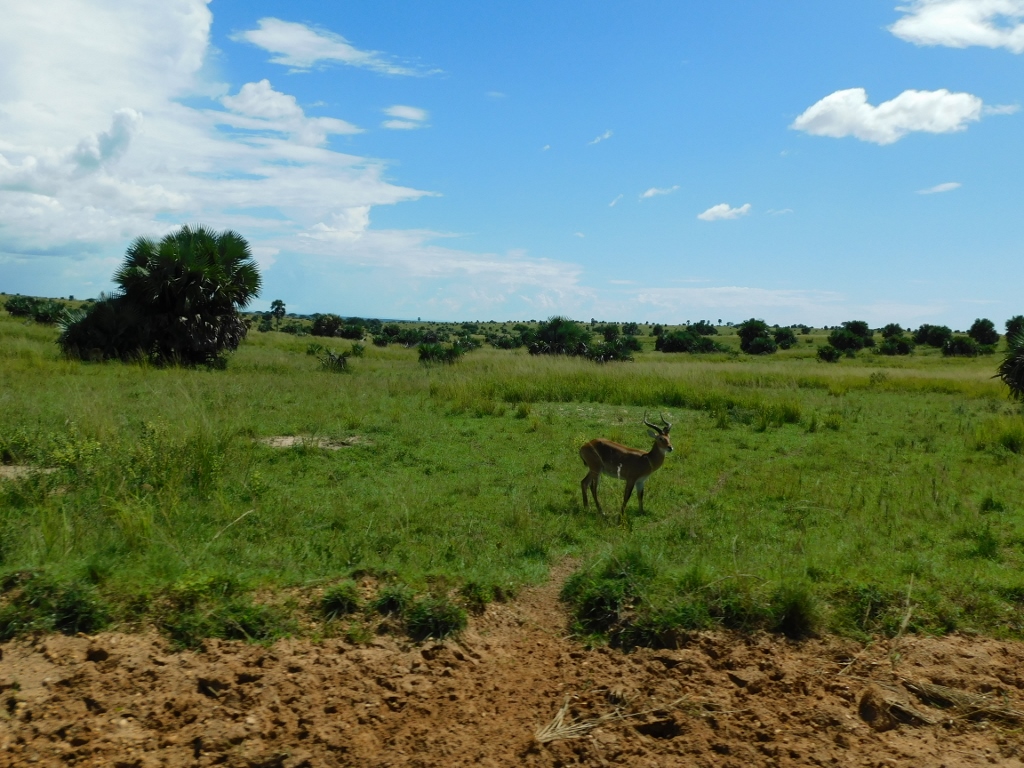 Murchison Falls NP
Murchison Falls NP
At some point, on a gentle incline in front of us, we also saw a few elephants. They were quite far away and partially hidden by grass due to the specific viewing angle.
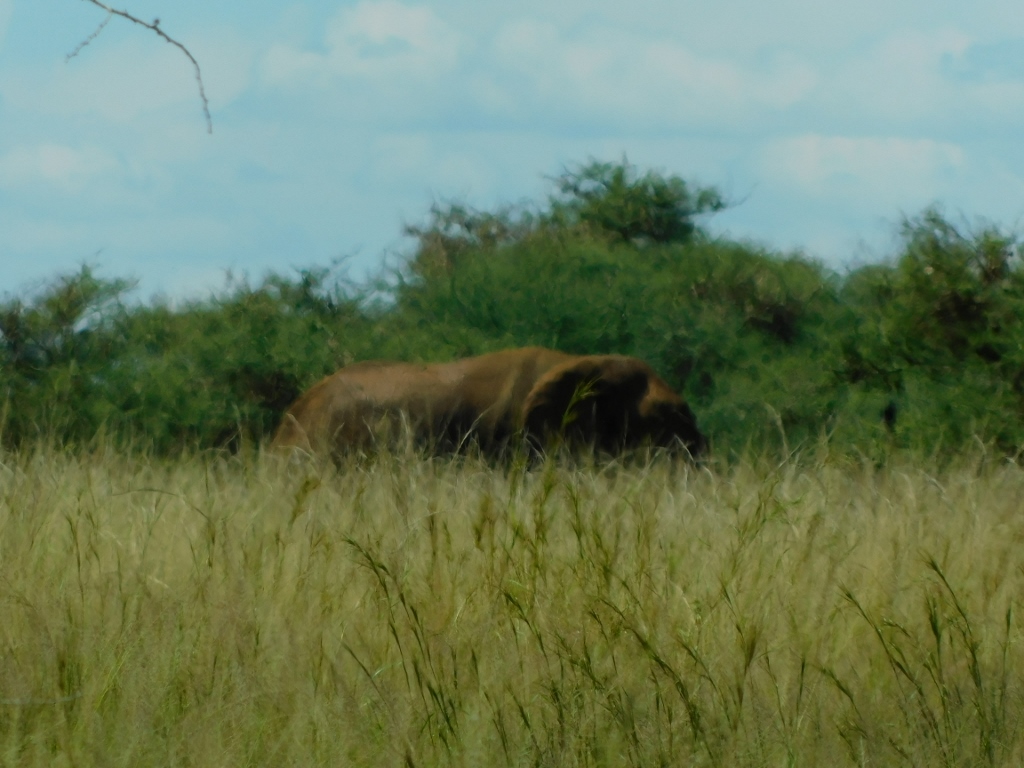 African bush elephant (Loxodonta africana)
African bush elephant (Loxodonta africana)
We had actually previously already spotted a large herd of elephants, but we couldn’t approach them at all because they were in an area not accessible to visitors due to oil exploration and drilling. It has been established that there are significant oil deposits beneath Murchison Falls National Park and Uganda is now working on exploiting its underground natural resources. I can, of course, completely understand this, but I hope that Uganda, its residents and its government will be wise enough to preserve their above-ground natural riches as well.
The Murchison Falls National Park is also home to lions, but we didn’t see them on this occasion. However, at one point, I saw large birds in the distance that I believe were vultures. If I’m correct, it would mean that someone had met with an unfortunate fate somewhere nearby and this means that lions might be in the vicinity as well.
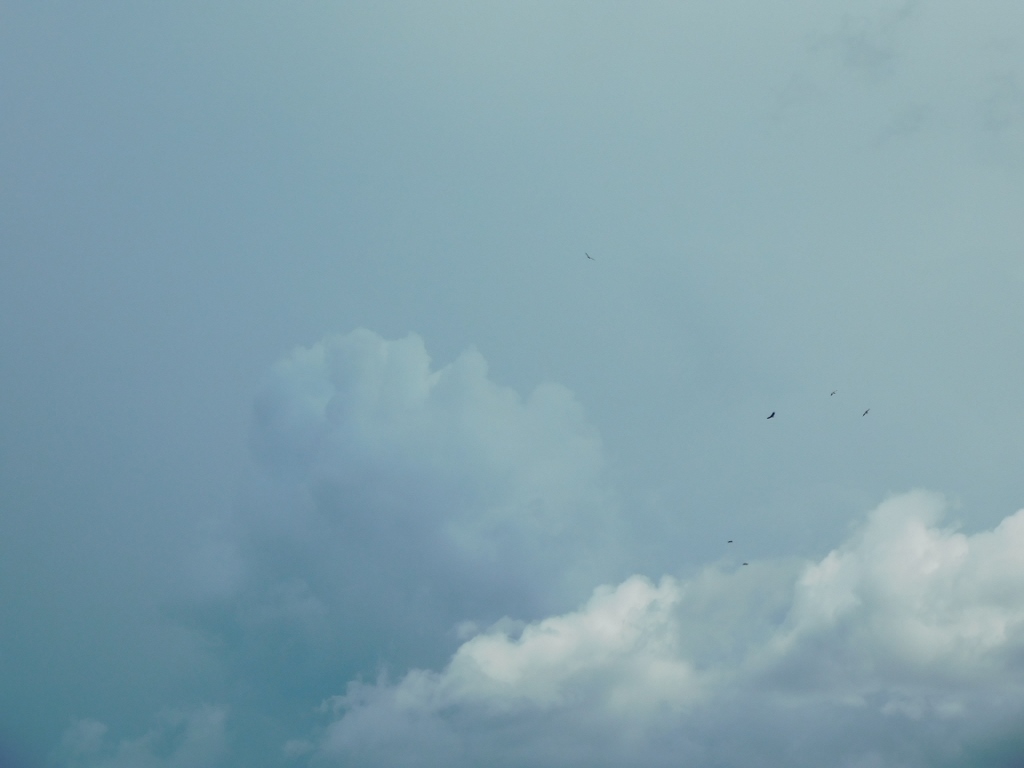 Murchison Falls NP
Murchison Falls NP
The forecast for the day mentioned the possibility of showers, but although rain clouds occasionally appeared in the sky, we were fortunate and no precipitation occurred in the areas through which we travelled.
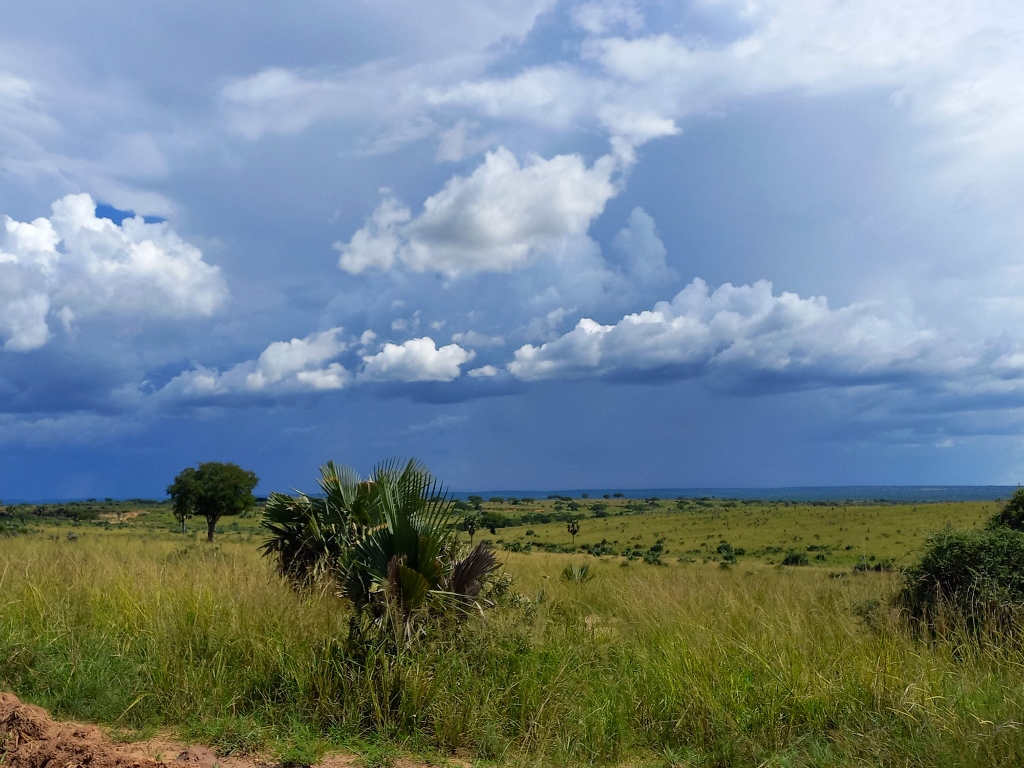 Murchison Falls NP
Murchison Falls NP
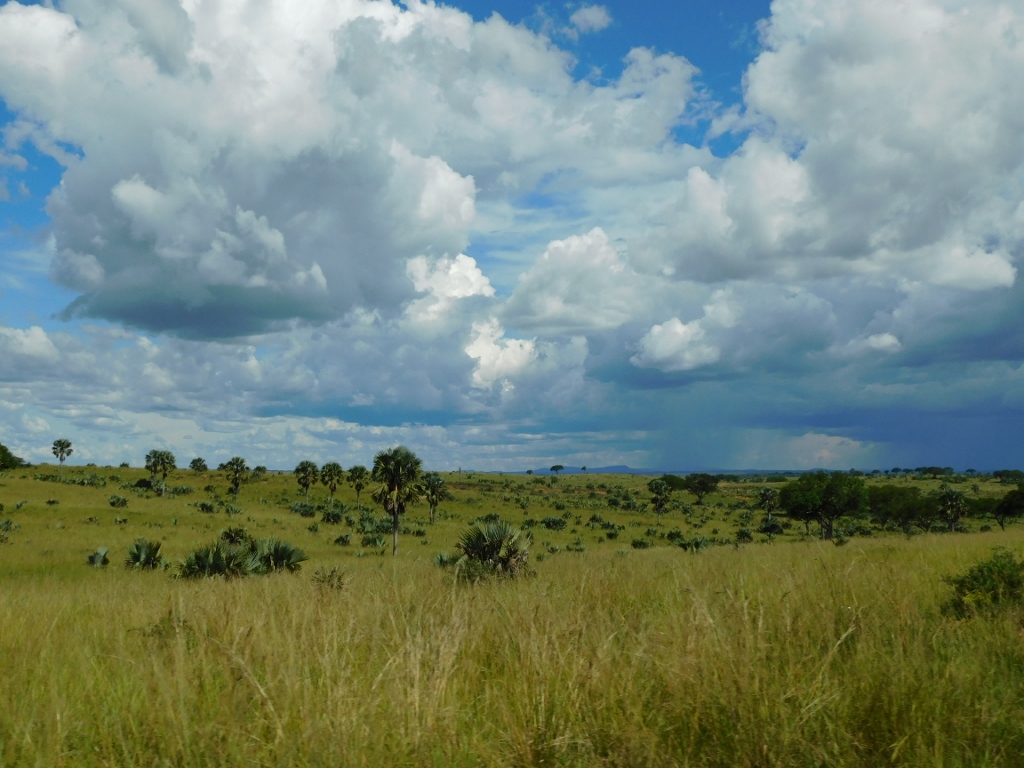 Murchison Falls NP
Murchison Falls NP
At the end of our tour, we returned the kind woman who was our guide to the same place where we had picked her up and then we set off again towards the bridge over the Victoria Nile. On the broad path leading to the riverbank, I noticed an antelope resting there. Perhaps it was the same male defassa waterbuck that had posed for us a bit farther away at the beginning of the tour.
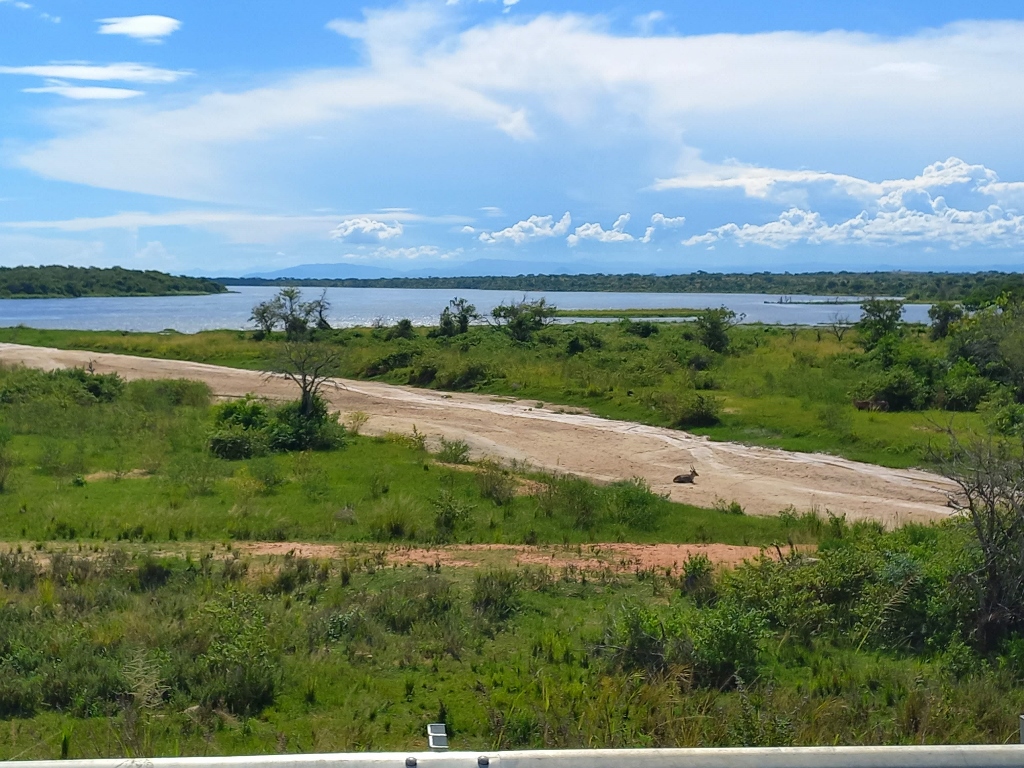 Murchison Falls NP
Murchison Falls NP
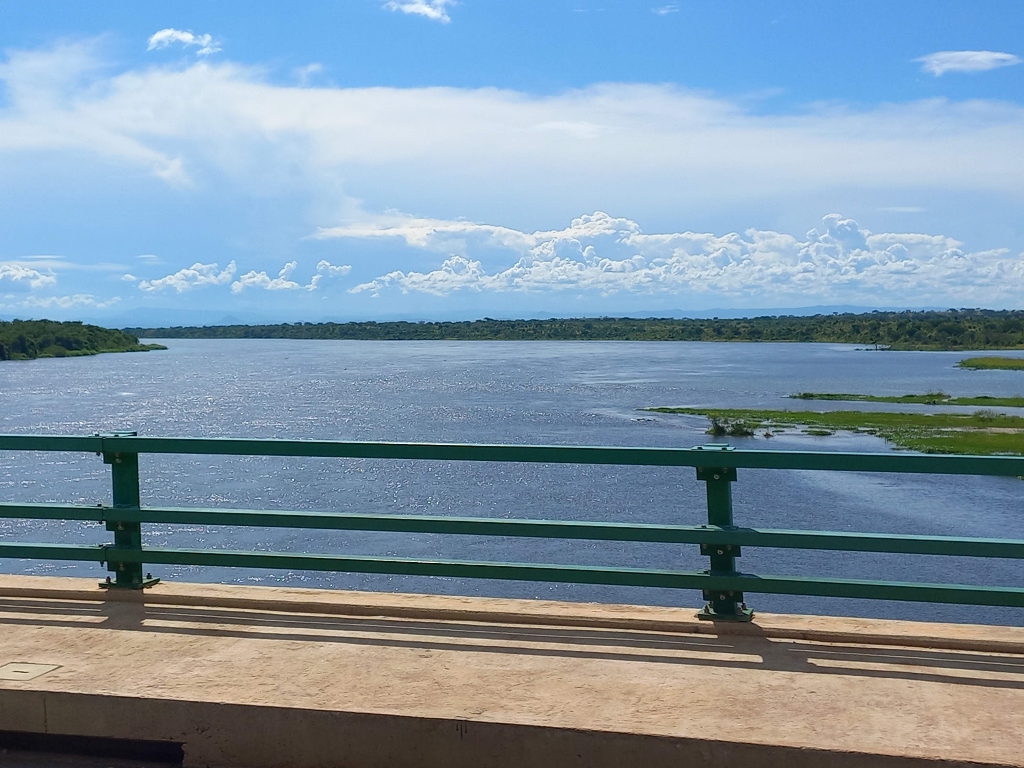 Murchison Falls NP
Murchison Falls NP
Now it was the time for a lunch break. Susan had arranged lunch for us at a restaurant offering traditional Ugandan food. Everything was very tasty and I thoroughly enjoyed it and even went back for seconds. I got to know about some local specialties and savoured them as well. For example, matoke, made of bananas (in the upper right-hand corner of the plate) and boo sauce, in the lower left corner of the plate.
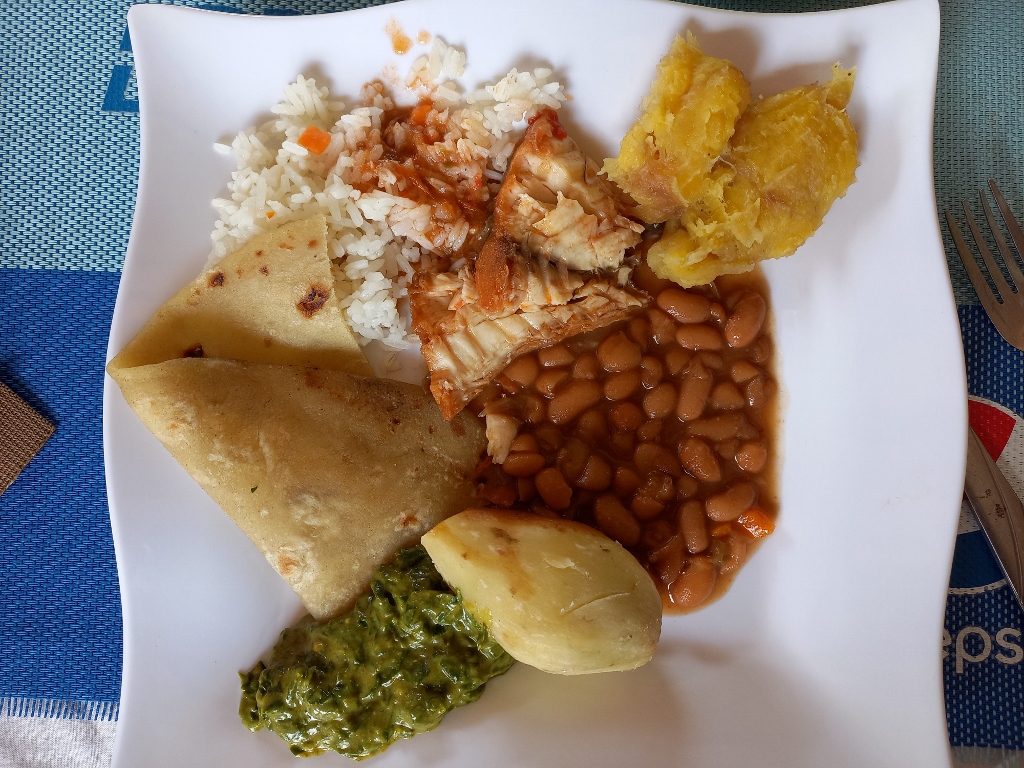 Traditional Ugandan food
Traditional Ugandan food
As for matoke, it didn’t even occur to me to ask for the recipe, as it involves a special type of bananas. Of course, boo sauce also requires some special ingredients, but you can also improvise, which I decided to do once I returned home. By the way, it’s interesting that boo sauce is often served at weddings because it’s believed to bring good luck. Later, Susan organised a demonstration of how this dish is prepared. Boo sauce is made from the leaves of young cowpea (Vigna unguiculata), but, as Susan told us and I also read online, it can be substituted with spinach. So, back at home, I made something that could be considered my version of boo sauce, since I really improvised, but it seems to me that the taste was quite close to the original, so I’ll share that version of the recipe. I don’t know what people from Uganda would say about my boo sauce, but I found it to be quite delicious.
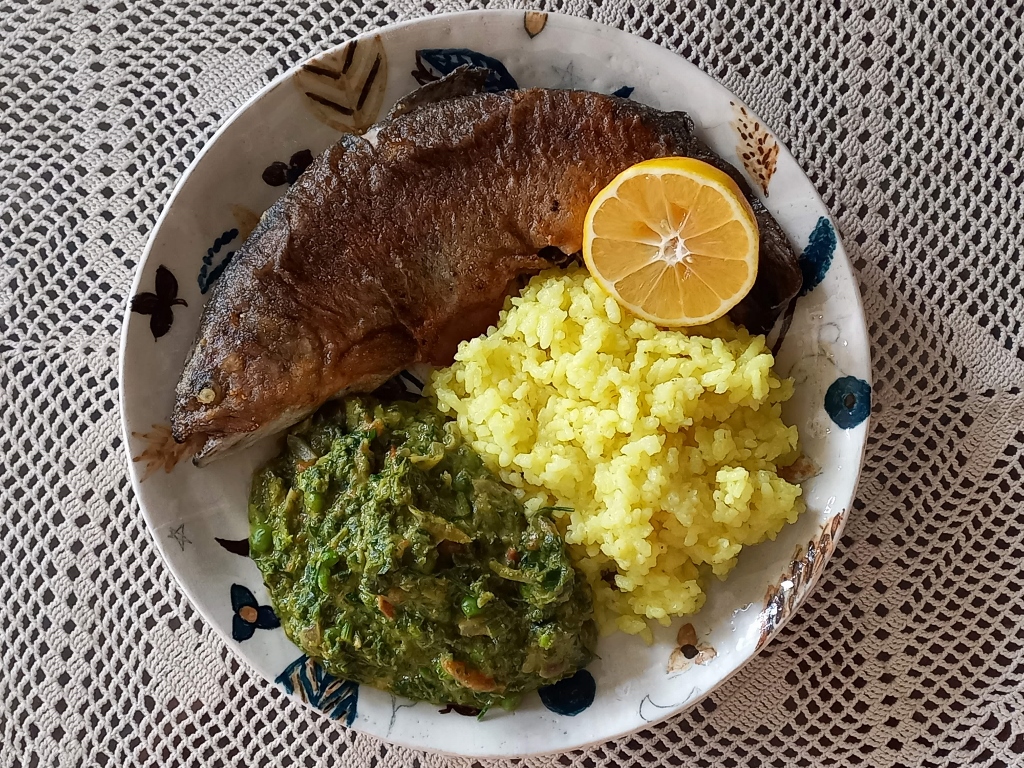 Boo sauce my way, served on a plate I have personally made
Boo sauce my way, served on a plate I have personally made
BOO SAUCE
- 1 small red onion
- 1 small tomato
- 200 g frozen spinach
- 50 g frozen peas
- 1/2 bunch of parsley
- some salt and pepper
- 2 tsp of peanut butter
- 2 tsp of tahini
The red onion and tomatoes are to be sliced very thinly. Since I used frozen spinach, I changed the order and method of preparation a bit. Therefore, I first sautéed the red onion and tomato in a little oil and when they softened, I added the spinach and peas. I included the peas as a homage to the cowpea leaves used in the original, although these are two completely different species, except that they belong to the *Fabaceae family. In any case, peas are green and that was important to me. That’s why I also added parsley, which is not in the original recipe.*
Add a little water and then cook while frequently stirring. The spices are added. If you like, a bit of chilli pepper and turmeric can also be added (my “inventions”). Once the vegetables are cooked, the peanut butter and tahini are added. Everything needs to be nicely combined.